SHOULD ALL HUNTERS BE SCREENED BY MENTAL HEALTH?
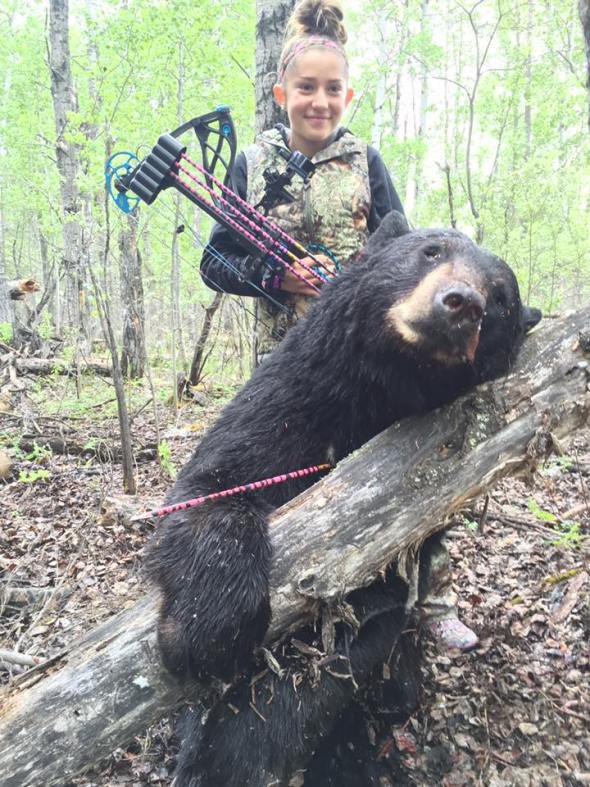
SHOULD ALL HUNTERS BE SCREENED BY MENTAL HEALTH?
Over the past five years I’ve noticed a worrying increase in the number of youth trophy hunters that are holidaying with their parents to Southern Africa for trophy hunting excursions. Some people may assume I’m being over-cautious or simply trying to stop the younger generation from undertaking a sport or so called tradition that they and their families enjoy.
Far from it; moreover I don’t believe its just the youth, that, in my eyes “would benefit from mental health screening”, but, instead all would be wannabe hunters, youth and adult, (basically anyone that wishes to acquire a hunting permit and firearms licence) to kill African wildlife and local wildlife endemic to their own country. Installing such strong and mandatory protocol - removes and/or bans mentally unstable individuals and sadists from out continent, temporarily or permanently.
Most if not all young hunters are American - standing at some 14 million and counting; furthermore there are few if any ‘requirements or checks carried out’ on the American youth or adult that applies for a hunting permit and firearms license within all states of America that could be hosting underlying mental health problems.
Today I witnessed yet again another hunter no older than ten years of age, holding a high-powered firearm, which to me on a professional note - I do find quite concerning - especially when a routine check of that individual showed up only one year of training. On researching the boy, his home town, hunting and firearm requirements . This ten year old child had to demonstrate that he was capable of handling a firearm, as well as being knowledgeable on firearm health and safety regulations.
Finally the young man “in America” must hunt with an adult over 21 years of age who’s holding a full clean hunting licence (none of which was being followed in the video). Now in relation to checks regarding “mental health screening”, the only checks that are undertaken are on those American citizens that have been “confirmed as mentally unwell/unstable, or are at risk of hurting themselves or others”.
Unfortunately under American law it does not state that all hunters must undergo a mental health check every six months to a year to rule out mental health problems ranging from depression, anxiety attacks, generalised anxiety disorder, panic disorder, obsessive-compulsive disorder, post‑traumatic stress disorder and social anxiety disorder (among many other clinical problems).
After much research, I’ve located that ‘in a number of states of America’ there are no laws or requirements whatsoever aimed at those wanting to hunt or apply for a firearms license. That I find incredibly worrying, if not bordering absolute crazy. A firearm in a sense is no different to a vehicle. Both are dangerous in the wrong untrained and unstable hands, and both can kill if due care and attention is not practiced.
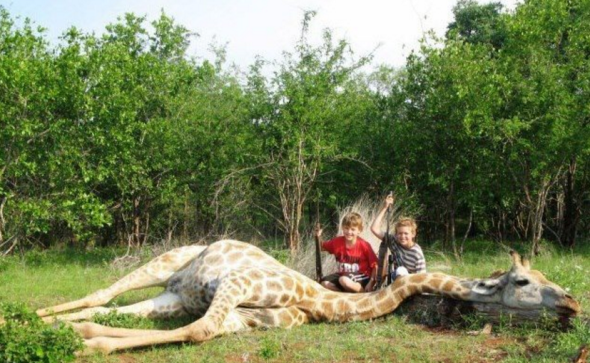
Image: Two American 10 year old’s kill giraffe
Meanwhile most American states host a ‘minimum age requirement’ to apply for a hunting licence, and firearms permit. The lowest minimum age is (ten years of age in some states) - again I find that very concerning, especially when the human brain is still developing from the ages of 1-21 years of age.
Fortunately most states though require some form of ‘education on handling and using a firearm’ with ‘firearms safety being a must’. Unfortunately this is not a requirement within a ‘few states’ from which any child of any age can apply for a hunting and firearms licence. Within them few states there are no laws whatsoever that state you have to undergo any form of firearms training and safety course, or even education on handling and using a firearm, furthermore there are no mandatory mental health checks!
So theoretically speaking we could have a large number of children and young adults hunting in Southern Africa that have no professional training whatsoever on how to use a firearm, not forgetting anyone of them hunters that could be hosting underlying mental health conditions such as: Generalised anxiety disorder, panic disorder, obsessive-compulsive disorder, post‑traumatic stress disorder, social anxiety disorder, psychotic depression, personality disorders, or even eating disorders, or children that are living within a ‘dysfunctional family setup’.
The minimum age that I myself could locate throughout all the American states listed here was (10 years of age and 12 years of age). Other state age requirements ranged from (16 years of age and 21 year of age). As you can see in the link above there are also some states that have no minimum age requirement, and within other states the only real requirements are that the young hunter is accompanied by a ‘qualified adult hunter’, or hunts within ‘a group of mixed age qualified hunters hunting a certain species’.
When scanning through all state requirements and those that hosted nothing more than word of mouth from an adult there wasn’t under any circumstances any form of mental health screening. The only concerns relating to mental health ‘were aimed at those that had been diagnosed with a serious mental health problem’ however even then the law states these individuals mustn’t be discriminated against. Another major concern was that very few state requirements undertook any form of background checks on the wannabe youth or near adult hunter.
So again, theoretically speaking, we could have in Southern Africa any child from the age of 10 years to 12 years. or near adult, that have committed anti social, and violent crimes or are hosting underlying mental health conditions, with little if any firearms training, hunting animals with high powered rifles. Furthermore if anyone of them youths or young adults were traumatized once killing a large animal it could exacerbate any underlying mental health problem thus seeing a potential crime being committed on the continent or once back home. As a specialist I’m absolutely gobsmacked that the United States Government haven’t as yet implemented more tougher and stringent firearm safety protocol.
While most states do require you to undergo a hunting education course, many of these courses can now be undertake online, from the comfort of your own home for as little as $25.00USD. There is no one monitoring the student to ensure they don’t cheat, there is no one with the student to ensure errors can be corrected, and finally once the course has been concluded - you can even print your own certificate off (should you pass that is). Most of these courses do not require you to attend a real live class (with instructor) to prove you’re capable of handling a firearm, and have grasped all the safety aspects of that firearm. Again I find that deeply worrying!
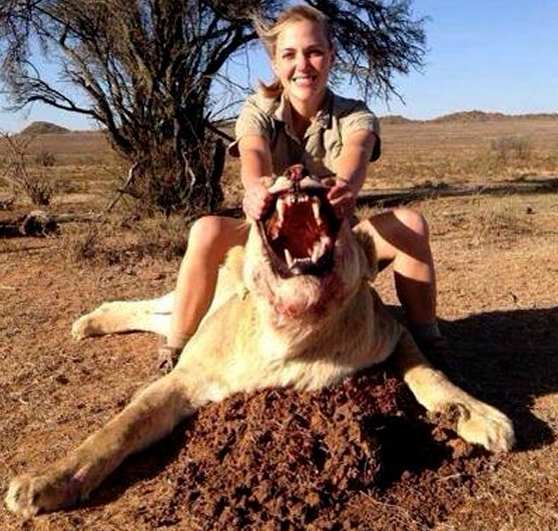
Image: Female lion hunter shows no respect whatsoever
So as explained above, within the past five years there has been a large spike in the number of young hunters entering Southern Africa. Most dangerous game hunts take place within South Africa where there is an abundance of heavily populated dangerous game. However when in South Africa the young are now hunting larger, and much dangerous animals, down to big yet friendly animals such as giraffes, rather than smaller animals in their own country. While this may not seem concerning; its very concerning if we have young and near adult hunters with little training (or no training) running amok in Southern Africa that (could be hosting underlying mental health problems).
Since 1966, the National Rifle Association has urged the federal government to address the problem of mental illness and violence. As we noted then, “the time is at hand to seek means by which society can identify, treat and temporarily isolate such individuals,” because “elimination of the instrument by which these crimes are committed cannot arrest the ravages of a psychotic murderer.”.
More recently, the NRA has supported legislation to ensure that appropriate records of those who have been judged mentally incompetent or involuntarily committed to mental institutions be made available for use in firearms transfer background checks. The NRA will support any reasonable step to fix America’s broken mental health system without intruding on the constitutional rights of Americans?
What the NRA is forgetting though, is that they’re only supporting legislation from which an ‘individual has been diagnosed with a mental illness’, rather than all individuals that could be harboring symptoms of mental illness, drug or alcohol abuse that haven’t as yet surfaced. As a professional and qualified neurologist, I find that incredibly concerning, that anyone who’s not undergone a routine mental health check - can apply for a hunting and firearms licence. Furthermore if symptoms of any underlying mental illness begin to surface and, rage out of control - can end in abuse, or worst case scenario - suicide or murder.
Meanwhile, while this area of regulation is not being monitored professionally then it is within my professional opinion (and that of other experts) that all countries on the African continent ban any youth and adult that hasn’t undergone a full psychiatric screening appointment. There is no harm in visiting a domestic psychiatrist or mental health community worker. Furthermore if there is an underlying condition found, that condition or symptoms can be professionally treated thus helping the individual, and eliminating any identified symptoms or an illness from becoming worse.
Another concern that I myself located within the federal laws of America is listed below for your information:
“A person cannot be federally disqualified from owning a gun based simply on a psychiatrist’s diagnosis, a doctor’s referral, or the opinion of a law enforcement officer, let alone based on getting a drug prescription or seeking mental health treatment. Doing so would actually discourage troubled people from getting the help they need”
I find that statement absolutely ludicrous. A psychiatrists diagnoses for instance is a professional diagnoses based on his or her expert findings; furthermore a psychiatrist has to undergo over twelve years of professional medical training in most cases. So why an individual that has for instance been diagnosed with a personality disorder cannot be federally disqualified for I don’t know. That itself is off the entire “stupid scale”.
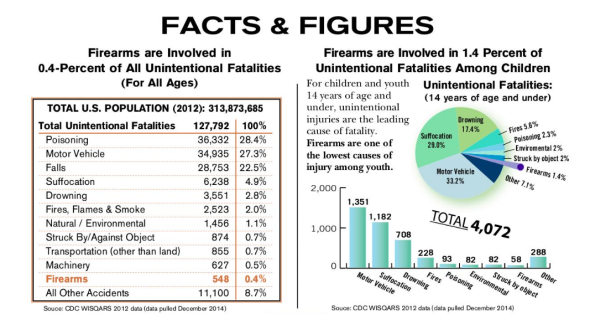
Image: 2014 states on unintentional firearms accidents on increasing
If this is how the NRA truly work then we seriously have major problems. Moreover how many individuals are there in America that have underlying mental problems, or have been diagnosed by a psychiatrist as suffering from depression, schizophrenia, manic depression, post traumatic stress disorder holding a full hunting and firearms licence - or been granted one with no checks based on the NRA and U.S. governments screening regulations? I am not under any circumstances, whatsoever trying to discriminate here, however if an individual is “clinically and mentally unstable” then providing a firearms and hunting license is a recipe for disaster.
Finally its in the interests of the psychiatrist and, the patient once a diagnoses (or degree of concern) has been made to then follow that report up, report to the individuals personal practitioner and help that individual ‘before a hunting or firearms licence is granted’. I’m somewhat perplexed as to why this area of ‘regulation’ would discourage troubled people from getting the help they need.
Furthermore under no circumstances should anyone be firing any form of firearm or operating anything ‘dangerous’, while under the influence of any medication that can induce sedation, drowsiness, lethargy, depression, mood swings, and agitation (among many mother prescription side effects). So again, in my professional opinion no government in anyone of the trophy hunting countries on the continent of Africa should be permitting any foreigner to hunt if they are under the influence of any type of medication, and not just psychotic medicines, as well as being diagnosed with a clinical mental health illness/problem/or/disorder.
SOURCE: https://www.nraila.org/articles/20130124/mental-health-and-firearms
Meanwhile, while mental health screening is indeed of a major concern, so to is that of uneducated, poorly trained or non-trained young hunters. To date there is (coincidentally) no database that reports on the number of youth hunting deaths in America. Furthermore trying to locate any statistics in relation to foreign African hunting deaths and accidents is like searching for a needle in a hay stack. That doesn’t though mean there isn’t any deaths or accidents, because there most certainly is!
Childhood gun and shooting accidents are not rare. They are one of the top ten leading causes of accidental death for all age groups outside of newborns and infants. Furthermore these known stats overtake those of adult hunting deaths. In 2007, there were 122 unintentional firearm deaths in children, and an additional 3,060 nonfatal gun and shooting accidents, which resulted in an estimated 1,375 children needing to be hospitalized for their injuries. Unintentional firearm deaths in children have remained at about the same levels since, with 114 deaths in children and teens less than age 18 in 2010.
How many childhood hunting accidents are there? That is hard to say (as explained), as there doesn’t seem to be a national database with hunting accident statistics. The Hunter Incident Clearinghouse of the International Hunter Education Association, which hasn’t been updated recently, reports 27 hunting-related shooting accidents in 2007 in children and teens less than 18 years old. This includes at least one death, a 14-year-old in Georgia who was unintentionally shot in the chest by another 14-year-old (who had completed a hunting education class) while they were hunting squirrels.
In 2006, the Hunter Incident Clearinghouse reported 3 deaths and 38 hunting-related shooting accidents in kids and teens. The youngest was just 5-years-old. To get more recent hunting accident statistics, you will likely have to go to each state’s wildlife conservation agency and try to find it (which is exactly what I’m doing.)
The National Shooting Sports Foundation likes to tout hunting accident statistics that rank hunting injuries as somewhere between playing billiards and bowling and much less than playing golf and tennis. To put this kind of thinking into perspective, though, compared to playing golf and tennis, isn’t a hunting injury that involves a shooting much more likely to be fatal? And it is these types of hunting-related shooting accidents that people are concerned about.
That doesn’t mean that you shouldn’t take your kids hunting. You just want to do it as safely as possible to help reduce your child’s risk of getting hurt and to avoid these types of hunting accidents and tragedies which have been reported in the last few years:
- A 14-year-old in Calaveras County, California who died after he was unintentionally shot by a 16-year-old while they were hunting.
- A 17-year-old in Anderson County, South Carolina who died after she was unintentionally shot in the back by her stepfather with his high-powered rifle as they hunted deer.
- A 10-year-old in Cache County, Utah who died after he was unintentionally shot by a hunting companion who was removing his rifle from the front of a four-wheeler, when it fired.
- A 16-year-old from Exeter, California who died while hunting with family and friends after he was unintentionally shot when he wandered in front of the other hunters.
- A 14-year-old from Palisade, Colorado who died after he was shot in the chest while bow hunting with his father.
- A 12-year-old in Stephens County, Oklahoma who was hospitalized after his 10-year-old brother unintentionally shot him in his backside after he tripped and fell with a gun in his hand while hunting.
- A 15-year-old in Minot, North Dakota who died while hunting with his father during the opening weekend of deer season.
- A man near Butte, Montana who was in a critical condition after he was unintentionally shot in the abdomen by a 13-year-old in his hunting party who was unloading his rifle.
Keep in mind that these incidents don’t include the perhaps even more common scenario of when a child or teen unintentionally shoots an adult in his hunting party. This happened recently when a 12-year-old shot a man he was hunting with in Iowa when his shotgun accidentally went off.
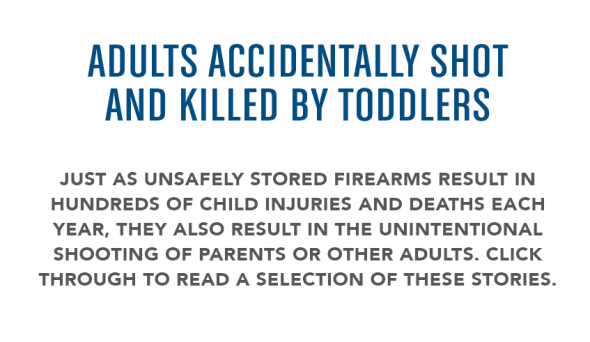
Image: Read more here: https://everytownresearch.org/reports/innocents_lost/
All of these reports are freely available (and there are hundreds). Furthermore these deaths and few accidents could have been avoided - had the young children been professionally educated, and monitored. Furthermore increasing the hunting age limit from 10-16 years of age (in most states) to above 18 years of age. Meanwhile in other states where there are no laws, or even the whiff of any gun control regulation, actually introducing such regulations and laws, and as stated above (ensuring that no one applies for a hunting permit or firearms license until 18 years of age or over).
SOURCE:
International Hunter Education Association. Hunter Incident Clearinghouse. 2007 Incident Summary. Accessed January 2013.
National Center for Injury Prevention and Control. WISQARS Nonfatal Injury Reports and Injury Mortality Reports. Accessed December 2012.
Study Guide for California Hunter Education Certificate. Accessed January 2013.
Keeping to the mental health side of things - back in 2010 the United Kingdom witnessed one of its worst firearms crimes seen since the Dunblane school massacre. Mr Derrick Bird whom fulfilled all the rifle and gun ownership laws (the strongest gun laws on the planet), as well as passing mental health assessments, shot dead 12 people, injuring a further 11 individuals, before taking his own life. The question is why did he decide that day to open up his gun cabinet and rampage through Cumbria killing many (and himself)?
WHY DID DERRICK BIRD KILL 12 PEOPLE BACK IN 2010?
First lets take a look at how Mr Bird was able to qualify for a gun and hunting licence. Getting a licence is a long and complicated business. Every stage of the process is designed to reduce the likelihood of a gun falling into the wrong hands. It starts with an application form which asks specific questions about why the individual wants a gun, telling them they need to show “good reason”.
The criteria are tougher for firearms than shotguns because weapons that fire bullets must only be used for specific purposes in specific places. These would include deer stalking or sports shooting on an approved range. In contrast, shotguns tend to be used in more general rural circumstances, such as by farmers who are protecting livestock from foxes - and police recognise that landowners need guns for pest control.
Independent referees provide confidential character statements in which they are expected to answer in detail about the applicant’s ‘mental state, home life and attitude towards guns’. Officers check the Police National Computer for a criminal record and they speak to the applicant’s GP for evidence of alcoholism, drug abuse or signs of personality disorder. Social services can also be asked for reasons to turn down an applicant. Finally, senior officers must be sure that prospective shotgun holders have a secure location for the weapon, typically a dedicated gun cabinet. Each certificate is valid for five years.
Mr Bird passed all the criteria for gun ownership, including a mental health examination, and drug and alcohol abuse surveys. Social services also assessed the applicant and stated that Mr Bird was in full state of mind, with no obvious signs of violence, nor was there any cause for concern relating to mental health problems.
However something changed, and that was Mr Birds mental health, which deteriorated rapidly resulting in 12 people being shot dead at point blank range, including a further two dozen more injuries. To date no one really knows for sure why Mr Bird decided that day in June 2010 to go on a killing spree.

Image: Mr Bird’s victims all shot at point blank range
However when Forensic Psychiatrists eventually delved deeper into Mr Birds past life right up to the day he began killing, then unearthed many ‘stress factors’. We know that stress can if not relieved lead to various forms of mental health problems, breakdowns or overloads to the point that an individual eventually explodes. It was stated that Mr Bird reached a ‘stress tipping point’ thus seeing no way out. From there he then killed, before taking his own life.
There has been speculation that Bird may have had a grudge against people associated with the Sellafield nuclear power plant that he worked for as a joiner, resigning in 1990 due to an allegation of theft of wood from the plant (stress 1). He was subsequently convicted, and given a 12-month suspended sentence. Three of the dead were former employees although there is no evidence that any were involved with his resignation.
Terry Kennedy, a fellow taxi driver who described himself as one of Bird’s best friends, and was wounded by Bird, has claimed that Bird had a relationship with a Thai girl he met on holiday in Pattaya, Thailand. It has been further claimed by another friend of Bird that he had sent £1,000 to the girl, who subsequently ended their relationship via a text message; he added that Bird had been “made a fool out of” (stress 2).
It has also been speculated that Bird had been involved with a family dispute over his father’s will. The speculation was heightened when it was revealed that Bird had targeted both his twin, David, and the family’s solicitor, Kevin Commons, in his attacks, killing both (stress 3).
Police investigating the killings have also found that Bird was the subject of an ongoing tax investigation by HM Revenue and Customs for tax evasion and the threat of possible future prosecution and punishment might have contributed to his action (stress 4). According to Mark Cooper, a fellow taxi driver who had known him for 15 years, Bird had accumulated £60,000 in a secret bank account and was worried he would be sent to prison for hiding the cash from HM Revenue & Customs.
So we know of four ‘speculated stresses’ that may have built up and up in Mr Birds personal life, of which its highly likely he eventually saw red, removed the firearms from his cabinet and killed 12 people before killing himself. However prior to these killings Mr Bird was seen as a stable, easy going, and nice chap, fun loving, was “one of the lads”, and socialized like any other individual. Unfortunately all four speculated stresses are what Police believe eventually led to Mr Bird going on a killing rampage.
Under U.K. law every five years a gun holder must reapply for a firearms license. The same checks, interviews and examinations are undertaken during every re-application for that license. These checks are there to ensure that both the firearms holder is stable, and to ensure the public are kept safe.
In today’s society bullying, mental health problems, anti social behavior, drug and alcohol abuse, pier pressure, violence, murder, rape, family problems, divorce and unemployment Etc are on the increase. These problems are not just confined to the United States neither. While in the United Kingdom Mr Bird had undergone various aptitude checks, mental health and social service checks, these checks are not being carried out on the millions of young and adult American trophy hunters.

Image: Press report of Birds rampage
Furthermore as explained above there have been a wide number of people killed by gun owners - and gun owners that haven’t undergone the correct or even adequate training. So the number of questions remain are: Why are these checks not being carried out, how long is it going to be before we see a stressed out trophy hunting teenager or, young adult going on the rampage in Southern Africa or America, why are no mental health checks and more than professional firearms training not being carried out in America before young hunters visit the African continent?
Every month now I am witnessing younger adults hunting in Southern Africa using a wide range of high powered firearms. On researching these children I find they are still at school. Furthermore on going through their ‘open public Facebook and Twitter accounts’ I am reading various problems from pier pressure, family relation problems, drug and alcohol abuse, bullying, school pressure, down to personal relationship problems too.
Finally when researching through every single gun shooting in the U.K. and the U.S. you eventually find that all of these shooters were emotionally and mentally to some degree unstable. In my personal and expert opinion its now time we either banned American hunters from Southern Africa that haven’t undergone the strict training and mental health checks, we increase the trophy hunting age from 16 to 21, we ban minor hunting, or we ban Americans from entering Africa that wish to hunt?
I have written an incredibly long document to each Environmental Affairs Ministry in Southern Africa and every single United States Senator. We need this area of lax gun and animal welfare laws tightened immediately. Enough is enough. In my humble opinion all hunters must be screened by mental health, doing so will see a decrease in hunting accidents, hunting gun crimes, and an improvement in animal welfare and rights laws - with far less animals slaughtered at the hands of sadists.
Dr Jose C. Depre PhD. MEnvSc. BSc(Hons) Botany, PhD(NeuroSci) D.V.M.
Master of Environmental, Botanical & Human Science.
Vegan Monday | Vegan French Dip Sandwiches | #TryVegan.

VEGAN FRENCH DIP SANDWICHES
Vegan Lundi
Every Monday and Friday - International Animal Rescue Foundation hosts a #TRYVEGAN recipe. We scan recipes from around the globe, convert them, the pubic send recipes to us to convert, or we simply publish our own recipes or that of third parties. We’ve made a small change to our hash-tag as we believe, in a way the “#GOVEGAN” tag is demanding, so we’ve changed that to #TRYVEGAN. What’s the harm in trying? Every Monday and Friday (two days a week) going completely meat, dairy and other animal products free from your normal diet.
Furthermore we’re not in the habit of publishing trash, such as plates of plain lettuce leaves, carrots, spinage or general boring recipes from which there is no goodness whatsoever, nutrients, fiber, protein, vitamins or minerals. Vegan foods must never be boring, and all you’re doing is removing the animal products and replacing that with a non-animal product. Today we’ve a small French recipe which is actually a rather tasty dish in France known as ‘dip sandwiches’. The meat of course has been removed. Try it, you’ll be amazed at just how tasty and filling this simple, easy to make dish is. I would advise to make your own French bread, alternatively, pick out some granary, gluten free French bread from your local continental farmers market.
INGREDIENTS:
2 tbsps olive oil (divided)
1 onions (medium, sliced into half rings)
2 garlic cloves (minced)
3 portobello caps (about 20 oz. total, cleaned and sliced into thin strips)
1 cup vegetable broth
1 tbsp soy sauce
1 tbsp vegan Worcestershire sauce
1/2 tsp dried thyme
1/4 tsp liquid smoke (optional, but highly recommended)
1/4 tsp black pepper
6 inches sandwich rolls (or baguette sections, sliced open) [Please do try French bread]
horseradish mustard
RECIPE:
Coat the bottom of a large skillet with 1 tablespoon of oil and place over medium-low heat. Add onion and toss a few times to coat with oil. Allow to cook until caramelized, about 20 minutes, flipping occasionally. Add garlic and cook about 2 minutes more. Transfer onions and garlic to a plate. Coat skillet with another tablespoon of oil and raise heat to medium. Add mushroom strips. Avoid overcrowding the skillet. A little overlapping is okay, but work in multiple batches if needed (I needed two), adding a bit of oil between batches if needed. Cook until lightly browned, about 5 minutes. Flip and cook 5 minutes more on opposite sides. Return onions to skillet and add broth, soy sauce, Worchestershire sauce, thyme, liquid smoke and pepper. Bring to a simmer and allow to cook, stirring occasionally, until liquid is reduced by half, about 5 minutes. Slather the insides of rolls with horseradish mustard. Use a slotted spoon to remove onions and mushrooms from skillet, pressing lightly to squeeze out any excess juice. Divide onions and mushrooms into rolls. Pour cooking liquid into a small bowl and serve with sandwiches, for dipping.
“IT REALLY IS THAT SIMPLE”
And if you want a sweet after, and think you’ve got what it takes to be a ‘French cook’ - which is pretty easy. Why not try French Vegan Gingerbread Toast Sticks.
ENJOY AND HAVE A NICE DAY.
Dr Jose C. Depre.
Endangered Species Monday | Tasmanian Devil | Sarcophilus harrisii.
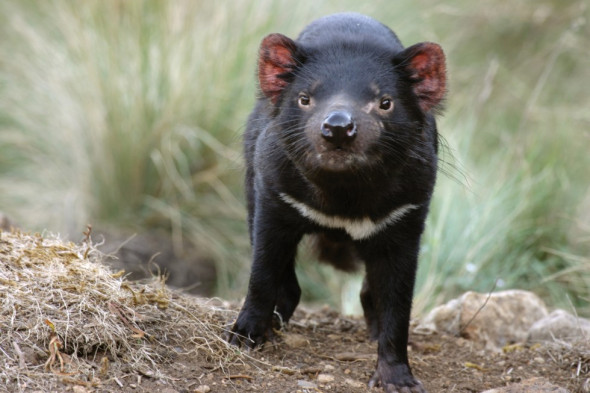
ENDANGERED SPECIES MONDAY | TASMANIAN DEVIL
This Mondays endangered species watch post (ESP) is dedicated to the Tasmanian devil, an endangered carnivorous marsupial that’s roughly the same size as a small domesticated canine. (Image credits: Bicheno Tasmania tourism)
The Tasmanian devil was formally identified back in 1841 by ‘French’ Dr Pierre Boitard (27 April 1787 Mâcon, Saône-et-Loire – 1859) whom was a French botanist and geologist. As well as describing and classifying the Tasmanian devil, he is notable for his fictional natural history Paris avant les hommes (Paris Before Man), published posthumously in 1861, which described a prehistoric ape-like human ancestor living in the region of Paris. He also wrote Curiosités d’histoire naturelle et astronomie amusante, Réalités fantastiques, Voyages dans les planètes, Manuel du naturaliste préparateur ou l’art d’empailler les animaux et de conserver les végétaux et les minéraux, and Manuel d’entomologie etc.
Listed as (endangered), and scientifically identified as Sarcophilus harrisii. Back in 1996 conservation scientists undertook further research on the species thus concluding the species was of ‘lower risk’. Unfortunately since 1996 - things have changed dramatically on the Australian continent. From the middle 1990’s conservationists estimated the mean mature individual total as being - 130,00-150,000 mature individuals.
Spotlighting sightings of Tasmanian devils across the state have declined significantly since the emergence of Devil Facial Tumour Disease (DFTD) in the mid-1990s: by 27% by early 2004, by 41% by early 2006, by 53% by early 2007, and by 64% by early 2008. The decline was significantly sharper in regions where DFTD had been reported earliest, such that in north-east Tasmania, mean sightings have declined by 95% from 1992-1995 to 2005-2007, with no indication of recovery or plateau in decline.
Comparison of mark-recapture results in the same area from the mid-1980s and 2007 supports this finding. At the Freycinet peninsula, on the east coast of Tasmania, where the population has been monitored through trapping from 1999 to the present, the population has declined by at least 60% since the disease was first detected in 2001 and the adult population still appears to be halving annually. Other indicators of devil abundance, such as road kills, predation on stock, and carrion removal, also support this conclusion of a substantial decline.
Surveys conducted back in 2007 ‘estimate the (mature) Tasmanian devil populations to be standing 25,000 being the highest estimate’; this equates to around 50,000 individuals. However back in 2004 conservationists stated the (mature populations) could be as low as 21,000 mature individuals. Conservationists have confirmed that due to the rapid spread of Devil Facial Tumor Disease, and other threats such as road accidents and predator kills - acknowledging these provisos, the best estimate of total population size based on current evidence thus lies within the range of 10,000-25,000 mature individuals. Based on threats, gestation, life span this therefore qualifies the species to be entered into [endangered category].
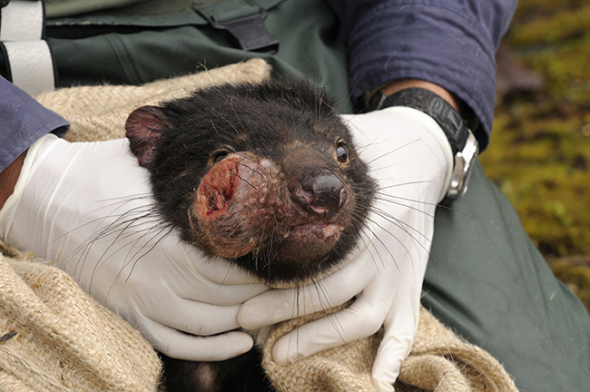
13 Feb 2011, Cradle Mountain-Lake St. Clair National Park, Tasmania, Australia — Tasmanian Devil (Sarcophilus harrisii) being treated by scientist for DFTD, Devil Facial Tumor Disease. This is a cancer that is spread by biting or physical contact from one animal to another, Cradle Mountain, Tasmania, Australia. — Image by © Dave Wattsl/Visuals Unlimited/Corbis.
In North-Western Australia Tasmanian devil populations are estimated to be standing at between (3,000-12,500 individuals). Meanwhile - in Eastern South Western Australia populations are said to be standing at 7,000 12,500 individuals.
Other trapping work by the Department of Primary Industry and Water (DPIW) Save the Tasmanian Devil Program broadly support these predictions for DFTD-free regions. However, in central and eastern regions, marked population declines have been detected, in association with the earlier reports of Devil Facial Tumour Disease (DFTD), subsequent to the time of the Jones and Rose survey. The north-west region is thus now thought to support the highest population densities.
The species is not known to be seriously or severely fragmented, however populations on the decline and fast, primarily due to Devil Facial Tumor Disease.
THREATS
Current evidence suggests that DFTD is an infectious, widespread disease, so that any attempt to delineate boundaries between affected and unaffected locations is likely to be outdated swiftly. DFTD has been associated with local population declines of up to 89% since first reported (Hawkins et al. 2006, McCallum et al. 2007), indicated by long-term spotlighting data, widespread trapping and laboratory results. The declines, and the prevalence of the disease, have not eased off in any monitoring sites, and DFTD is present even in very low density areas.
It is estimated that the adult population is approximately halving annually on the Freycinet peninsula with extinction predicted at this site 10-15 years after disease arrival. Declines were most marked in areas where the disease had been reported earliest, in north-eastern and central eastern Tasmania.
Mean spotlighting sightings of Tasmanian devils per 10 km route, obtained from across the core Tasmanian devil range (eastern and north-western Tasmania), have declined by 53% since the first report of DFTD-like symptoms in 1996. The most immediately threatened location is thought to be the region where DFTD was reported prior to 2003: across 15,000 km² of eastern Tasmania.
By 2005, the Devil Disease Project Team had confirmed DFTD in individuals found across 36,000 km² of eastern and central Tasmania. DFTD is now confirmed across more than 60% of the devil’s overall distribution, and there is evidence for continued geographical spread of the disease, so that Tasmanian devils across between 51% and 100% of Tasmania may be, or have already been, subject to >90% declines in a ten-year period. The currently affected region covers the majority of the formerly high-density eastern management unit, involving what was perhaps around 80% of the total population.
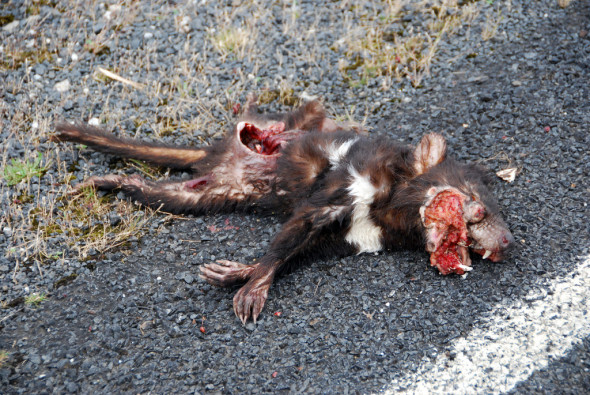
Image: Tasmanian devil killed by car/with suspected DFTD.
DTFD has resulted in the progressive loss of first the older adults from the population and then the younger adults so that populations are comprised of one and two year old’s. As female devils usually breed for the first time at age two, they may not successfully raise a litter before they die of DFTD. An increase in precocial breeding indicates some compensatory response, but as yet this appears to have been insufficient to counter mortality.
DFTD behaves like a frequency-dependent disease, probably because the majority of the injurious biting, which is the type of contact most likely to lead to disease transmission, occurs between adults during the mating season. Frequency-dependent diseases, which are typically sexually transmitted, can lead to extinction. Because transmission occurs between the sexes at mating irrespective of population density, these types of diseases lack a threshold density below which they become extinct.
Cannibalism is considered fairly common in Tasmanian devils and renders the species particularly vulnerable to disease transmission. However, modes of transmission of DFTD are not as yet known.
ROAD KILLS:
A recent three-year study of roadkill frequency on the main roads of Tasmania estimated 2,205 Tasmanian devils are killed on roads annually. This suggests that 2-3.% of the total Tasmanian devil population are killed on roads (based on an estimated population of 60,000–90,000 individuals at the time of the survey). The roaded parts of Tasmania closely match the core distribution area for Tasmanian devils.
Roadkill was attributed as the cause of up to 50% and 20% of Tasmanian devil death during a recording period of 17 months at Cradle Mountain and 12 months at Freycinet National Parks, respectively. Local extinction and a similar rate of population decline at Cradle Mountain indicates that roadkill can cause local extinction, in which the road becomes a local sink. Future impact is likely to remain at the same level.
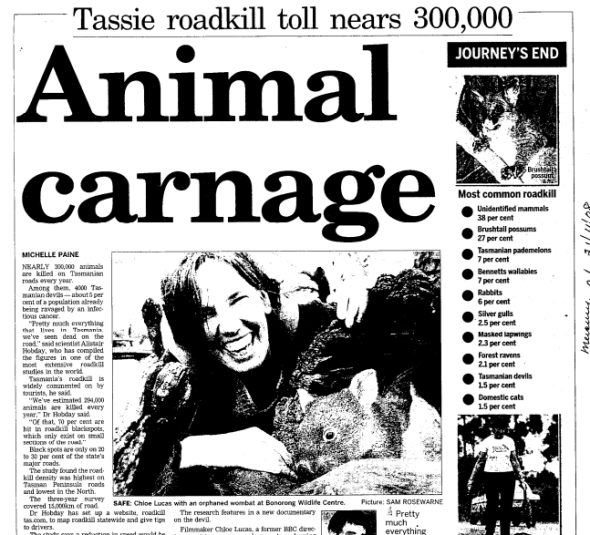
Image: Paper cutting relating to 3 year study of fauna road kill.
DOG KILLS:
Reports of about 50 devils killed per year by poorly controlled dogs are served from about 20 dog owners. There is no obligation or incentive for such reports, and generally some hesitance even among those providing them, so the real figures are more likely of the order of several hundred devils killed by dogs each year.
FOXES:
There have been spasmodic, small-scale introductions of the Red Fox (Vulpes vulpes) into Tasmania since early European colonisation. Early incursions were sometimes efforts at acclimatisation and others for short-term hunting. More recently, there has been at least one accidental incursion (from a container ship in 1998) and credible reports of a concerted, malicious campaign of introduction.
Hard evidence (confirmed scats, carcasses) of foxes has been found in the north-west and northern and southern midlands. Credible sighting reports have come from most of the eastern half of the State including the central highlands and the far north-west, mostly areas where Tasmanian devil populations are suppressed by DFTD.
A commonly held view has been that the abundance of Tasmanian devils has prevented fox establishment through interference competition, either aggressive exclusion or predation on denned juveniles. Red Foxes and Tasmanian devils share preferences for den sites and habitat, and are of a similar size. Tasmanian devils abundance is likely to slow, if not prevent, fox establishment.
It is possible that foxes have been present in Tasmania for many decades at sub-detectable levels, and that a degree of ecological release has occurred due to DFTD, with foxes increasing to detectable numbers. The current impact of the Red Fox has been quantified, and it is unlikely that fox numbers are currently at a level to impose a measurable impact.
A decline in Tasmanian devils number may create a short to medium-term surplus of food, for example carrion; ideal for fox establishment. Fox establishment may cause both direct and indirect effects on Tasmanian devils. Direct effects include (reciprocal) killing by then abundant foxes of then rare juvenile devils at dens while the female forages.
Fox establishment may also cause ecosystem disruptions through changes in other species - a feature of foxes on mainland Australia and something that might then also indirectly affect Tasmanian devils. Tasmania has the potential to hold up to 250,000 foxes (based on modelling of habitat preferences and densities in south-east mainland Australian) which could replace most medium- to large-sized marsupial carnivores.

Image: Red foxes have been reported to prey on Tasmanian devils/Other Marsupials.
PERSECUTION:
In the past, persecution of the Tasmanian devil has been very high throughout settled parts of Tasmania, and is thought to have brought about very low numbers at times. Through the 1980s and 1990s, systematic poisoning in many sheep-growing areas (particularly fine-wool with its reliance on merinos) was widespread and probably killed in excess of 5000 devils per year. In the 1990s, control permits were occasionally issued to individuals who were able to argue that Tasmanian devils were pests (e.g. killing valuable lambs).
Current persecution is much reduced, but can still be locally intense with in excess of 500 devils thought to be killed per year. However, this is reducing since devil numbers have declined. While the small amount of current persecution is likely to persist it is unlikely to constitute a major threat unless the Tasmanian devil population becomes extremely small and fragmented.
LOW GENETIC DIVERSITY:
Dr Jones in 2004 found the genetic diversity of Tasmanian devils to be low relative to many Australian marsupials as well as placental carnivores. This was consistent with an island founder effect, but previous marked reductions in population size may also have played a role. Low genetic diversity can reduce population viability, and resistance to disease.
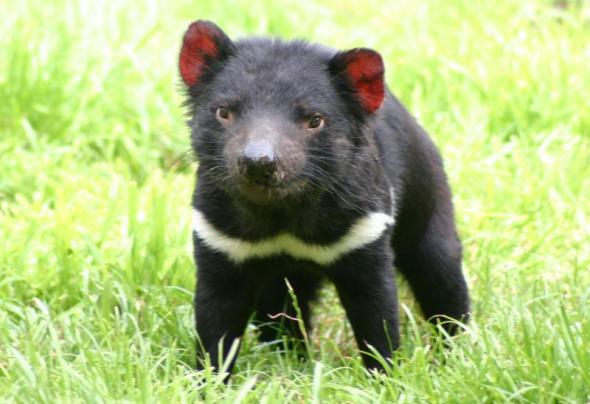
Image: Tasmanian devil (photographer unknown).
Tasmanian devils normally eat birds, snakes, fish, reptiles and insects. Furthermore its not uncommon to witness the species feasting on dead carrion. Female devils will mate with dominant males, who fight to gain their attention. Three weeks after conception, the females ‘can’ give birth to up to FIFTY BABIES, called joeys, although some reports state between 20-30 joeys. These extremely tiny joeys scramble to attach themselves to one of the four available teats in the mother’s pouch. Gestation is around 21 days.
For now the future is uncertain with regards to the Tasmanian devil. The species hosts a large number of natural threats, as well as roadkill accidents, human persecution and (DFTD). For now populations are considered to be generally high, although not that high for the species to qualify as vulnerable, or even near threatened. There are a number of Australian marsupials facing many threats, despite the continent being inhabited at some 10% by humans, or to be precise - 768,685 km2.
While I myself cannot state for certain what the future may hold for the Tasmanian devil - for now based on the large number of threats and continued population declines - its highly likely that come 2026 we’ll be seeing yet another Australian extinction occurring under our noses, and that is the sad reality of life from which our wildlife is facing today.
One thing is for sure though - never underestimate the DEVIL - they’re not called devils for nothing and have a rather cute temper too. Welcome to the planets largest carnivorousness marsupial. The Tasmanian devil
Thank you for reading.
Dr Jose C. Depre PhD. MEnvSc. BSc(Hons) Botany, PhD(NeuroSci) D.V.M.
Master Scientist of Environmental, Botanical & Human Science
CYPRUS: WELCOME TO THE SONGBIRD KILLING FIELDS.
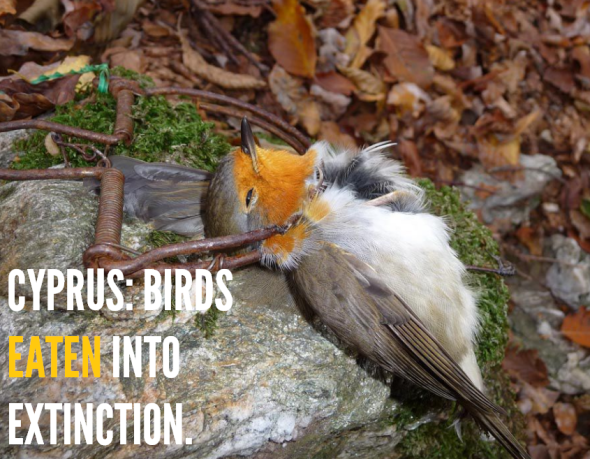
WELCOME TO THE CYPRUS KILLING FIELDS
Just over a week ago, while walking through the local woodland gardens, I noticed a little European robin that just happened to perch next to a fence no more than a few meters in front of me. I was taken aback because, this was the first robin sighting in as many years, today its actually quite rare to spot them, and while I embraced the moment, it dawned on me, why wasn’t I witnessing more of these beautiful birds within the wild?.
Robins normally head south to winter on the Continent, joining other robins passing through in the autumn on their way from Scandinavia and northern continental Europe. Interestingly, it has been shown that many migrating robins are faithful to both their summer and winter territories, which may be many hundreds of kilometers apart. Regardless of where they migrate though I myself and many other conservationist’s are seeing fewer and fewer robins and other song birds.
Every day when I awake I spend a few minutes trying to identify the number of songbirds singing within the wild within the confines of my garden. One can normally identify each individual species of bird by its unique signature melody. As a young boy it was almost difficult to identify more than a handful due to so many songbird species inhabiting the local areas. Today I can identify no more than two or three if that, and in relation to the rare sightings of robins and songbirds - this tells me only one thing - we’re losing our songbirds at an alarming rate!.
Its estimated every year that a staggering TWENTY SEVEN MILLION songbirds are slaughtered on the Mediterranean. Songbirds are unfortunately ending up on the plates of many Cypriots - to the tune of some 1.3 million, of which this number is increasing every year. Cyprus like every country hosts a wide range of traditional and culinary delights. However this culinary tradition must come to an abrupt end - very soon across the entire Mediterranean (not just Cyprus), failing this mass songbird extinctions will occur.

Image: Poached robin, (inset) ambelopoulia song bird delicacy.
Unfortunately one of them so called ‘traditional culinary delights’ is that of boiled songbirds. And please don’t for one minute think I’m singling out Cyprus here. My own country hosts a number of nauseating traditional foods that sees ducks, geese even swans butchered to provide Foie Gras and, songbirds too. Germany sells a number of robin dishes, while Malta is an even bigger offender killing hundreds of thousands of birds every year just to provide a so called “traditional food” for the locals and foreigners. Songbirds are vanishing from the Mediterranean, and the rate at which they’re being eaten is very likely to push many species into extinction in the next decade.
Cyprus has a plethora of customs due to its long history and tradition and numerous distinctive dishes for visitors to taste. The best place to do this is in one of the many traditional tavernas dotted around the island’s attractive villages, where one could order a selection of Cyprus dishes such as koupepia, souvla, kolokasi, pourgouri, seftalies and makaronia tou fournou to name just a few. For the ultimate gastronomic experience in Cyprus, the best way to try all of these and more in one sitting is as ‘mezedes’, a selection of more than 20 vegetable and meat dishes – make sure you are hungry as food will be plentiful.
However while all of these dishes may sound, look and even taste nice, a large minority of individuals on the island of Cyprus (not all), indulge in the local and traditional delicacy of boiled or grilled songbirds. Back in 1974 the government of Cyprus was lobbied and pressured to ban songbird trapping, and poaching. Today its currently still illegal to trap songbirds (as seen in the image above). While these laws prohibit anyone from illegally trapping, killing and serving up ambelopoulia - the law is very rarely enforced, which does concern us dearly. Furthermore what’s the point in having laws in place (since the 1970’s) if you’re not going to follow through with them?
AMBELOPOULIA
Mention ambelopoulia to a songbird - and it sends shivers through them, (well not literally); ambelopoulia is though the main Cyprus culinary delight - of which songbirds are pickled, roasted, grilled or boiled served with a number of vegetables or sweet fruit sauces. The traditional food normally involves boiling songbirds. The two common species of birds eaten are that of blackcaps and European robins - which is probably why I’m seeing fewer songbirds every year.
As a result almost 2,418,000 birds across the whole of Cyprus were estimated to have been killed during 2010. According to a BirdLife Cyprus report released in 2014, over 1.5 million migrating songbirds are killed annually, and the number is increasing each year. In 2015 it was estimated that over 2 million birds were killed including over 800,000 on the British Territories. Now there are new reports issued this year by various bird groups that confirm we are losing a staggering 27 million songbirds every year on the Mediterranean - many of which are killed for human delicacies.
Songbirds are trapped, killed, trafficked and consumed within many European countries. Spain, Germany, Italy, France, Belgium, Greece, Romania, Serbia, Slovenia, Russia, Malta, and of course Cyprus - all of which is mostly illegal. What makes matters even worse (in relation to Cyprus) is that a large number of songbirds are actually killed on the local British military bases on the island, so why are the Brits allowing this dare I ask?. Birdlife Cyprus stated in a report this year: “Over 800,000 birds were trapped and killed illegally on a British military base in Cyprus last autumn, according to the latest research by the RSPB and BirdLife Cyprus”.
Organised crime gangs are running this illegal practice on an ‘industrial scale’, which is estimated by the Cypriot authorities to earn criminals on the island 15 million Euros every year. Survey data from BirdLife Cyprus and other organisations have recorded over 150 species of bird which have become trapped in mist nets or on lime-sticks (pictured below). More than half of these species are of conservation concern. On a positive note, the results from 2015 show that there’s been a stop to the ‘annual increases’ of the last five years in numbers of birds killed on British Territory, thanks to various measures taken to tackle the problem by the Base authorities. The numbers however remain around record-breaking levels, with levels of illegal killing still far worse on British Territory than in the Republic of Cyprus.
The trappers defend their activity by citing the practice as traditional Cypriot food gathering and claiming that this has been an important source of protein for the natives for many thousands of years, even though the practice has been illegal since 1974. BirdLife Cyprus has identified restaurants as the main culprits as they provide the financial incentives. The enthusiasm Cypriots and many other visitors to the island have for this delicacy despite its illegality has resulted in the development of a very profitable industry.
Poaching for ambelopoulia has been on the rise in recent years, involving by 2011 a “mafia-like operation” that include poachers, dealers, exporters, and restaurant operators that participate in the illegal business estimated to be worth about 5 million euro at that time (2011). The birds reportedly sell for five euros each and it is estimated by Cypriot authorities to have earned criminals on the island 15 million euro in 2015.
LIME STICKS
Cypriot poachers illegally poach songbirds using a number of methods. One of them (seen pictured below) are lime sticks. The use of lime sticks is ‘strictly illegal’, however as explained above, despite laws in place on the island local authorities still turn a blind eye.
Lime sticks are a simple but particularly cruel and indiscriminate method of trapping birds. ‘Twigs’ are covered with a sticky ‘lime’ or ‘glue’ (in Cyprus trappers traditionally used a concentrate made from boiled Syrian plums) and are placed wherever birds can be tempted to perch. This could be in natural vegetation like bushes or trees, or sometimes lime sticks are pushed into the ends of bamboo poles. And as you guessed - once the bird lands on the lime stick they are stuck fast.
The more the bird struggles, the more it becomes entangled within the sticky like natural/unnatural substance. Songbirds die a horrific death, struggling for hours before being crushed to death by poachers, or dying of extreme exhaustion and stress. Just in one area (such as local gardens alone), its estimated that ‘hundreds of lime sticks are set up to catch as many birds as possible’. More than TWO MILLION songbirds are illegally poached using this method of trapping - which is cruel, painful, and totally barbaric.
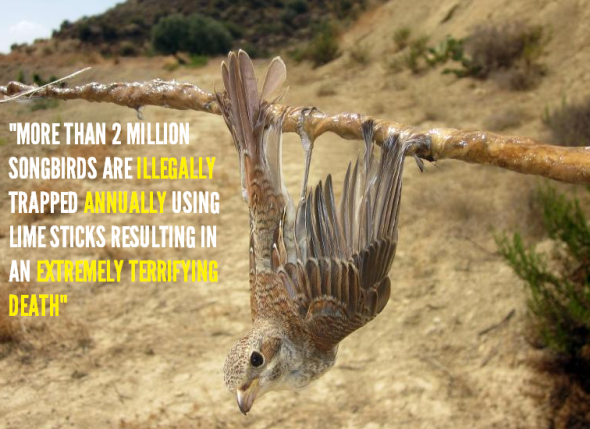
Image: Lanius collurio (Red Backed Shrike) trapped using a lime stick.
In Cyprus alone its “estimated that some one million songbirds are caught using this method of illegal trapping. Most of the sticks are set up within residents gardens - which makes policing even more difficult. One must also think - how is it even possible for every single home within Cyprus to be monitored by the local authorities?.
Lime sticks are so effective because when a bird lands its legs bend causing two flexor tendons to tighten which ‘lock’ the toes around a perch. This involuntary reflex (designed to stop perched birds falling while they sleep) means that the bird in effect presses down hard into the ‘lime’ as soon as it makes contact with it. Birds become stuck immediately. As they flutter to free themselves their wings, head, and even beak will often become stuck too.
“TRAPPERS RIP THE BIRDS FROM THE LIME STICK AND CRUSH THEM TO DEATH”
Birds caught on lime sticks are unable to get free and hang helplessly – often for hours – until the trapper comes and literally rips them off the stick and crushes them to death.
Article 9 of the European Birds Directive (2009/147/EC, formerly 79/409/EEC), states that trapping methods that are non-selective or are used for large-scale capture or killing of birds are prohibited in European Member States. This includes lime sticks, and their manufacture, sale, ownership, and use is therefore illegal across the EU. Unfortunately while this horrific method of trapping may indeed be illegal - poachers are still getting away with murder.
MIST NETS
I’ve spent a number of years living on the small island of Malta (on and off) and, a number of years trying to destroy these bloody nets with the help of many local and overseas activists. Mist nets are just as cruel and barbaric as lime sticks, although I must state that birds are caught instantly, and killed there and then - nevertheless their deaths are still horrific.
Mist nets are often use by poachers on the island of Cyprus to catch a larger number of birds, meanwhile these very same poachers will also have lime sticks deployed within key areas. So it kind if gives you a little more insight into just how greedy poachers and buyers have become. Furthermore the rate at which we’re losing songbirds - and the levels of poaching increasing, what’s next when extinction finally does occur. Mist nets are also used within Spain, France, Romania, and Germany (among many other EU countries).
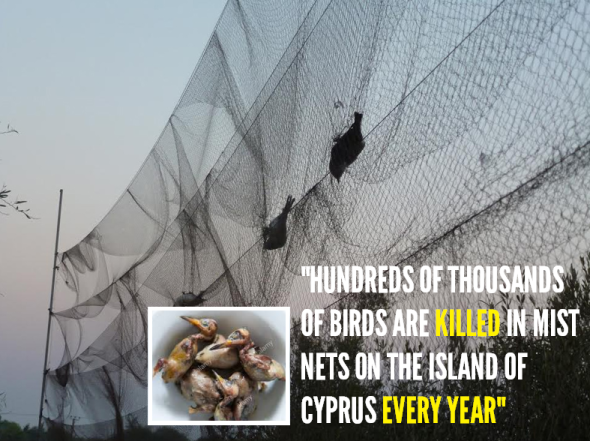
Image: Mist nest. Inset is the local delicacy of Cyprus.
Its estimated (just in Cyprus alone), hundreds of thousands of birds are caught and brutally slaughtered within mist nets every year, and with over a million more using lime sticks - and with laws rarely enforced on the island of Cyprus, will we be seeing a colossal extinction soon of migrating songbirds? I hate to say this, but unless laws are enforced and action is taken against poachers on a larger scale - extinctions will occur.
International Animal Rescue Foundation France has thus far located a total of 139 restaurants on the island of Cyprus, of which we have uncovered out of them 139 some 24 which are selling illegally ambelopoulia. I.A.R.F.F believe that the number of restaurants illegally trading ambelopoulia is much greater than 24. Furthermore due to the dish being so popular and craved after, its highly likely that the ‘majority’ of restaurants are trading ambelopoulia. International Animal Rescue Foundation France are calling on all tourists to please BOYCOTT all Cyprus restaurants that are trading openly this vile and cruel so called delicacy.
The birds sell for approximately CY2.00. One tourist stated: “Consumers are encouraged to swallow the bird whole”. On a plate you’re normally served in between four to five songbirds, and a number of other dishes too. If you are a tourist please, please do not indulge in this delicacy, and report the restaurant immediately to the local police. Another tourist that visited the area of Laxia, stated: “Laxia is somewhat of a favorite with the police, mayor and local mafia. So if there’s anything illegal going on you’ll probably find it there”. From what we are aware locals don’t encourage you to swallow the dead boiled bird[s] whole, however it wouldn’t be somewhat of a shock if this was factual.
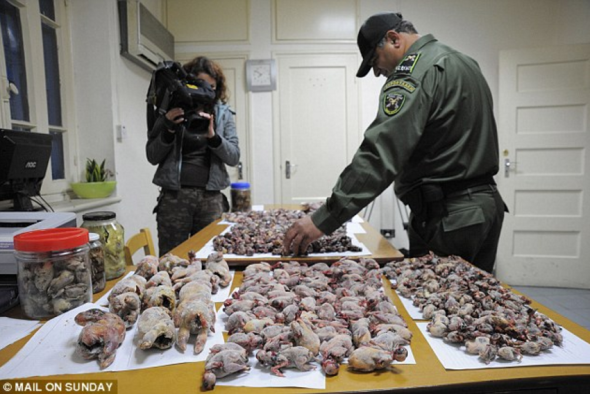
Image: Poached songbirds confiscated from poachers on the UK armed forces base.
“WHY ARE SONG BIRDS IMPORTANT?”
Songbirds are an incredibly important species of bird consisting of over 159 separate species that are endemic mostly to Europe, and as far away as Asia, America, Canada and Africa. While eating them may seem “important or traditional”, scientifically speaking you’re actually harming the environment, and removing yet another food chain link that many other species of animals depend on.
For management purposes, songbirds are part of a group called “land birds,” species that rely mainly on terrestrial habitats and some vegetated wetlands. Songbirds eat a wide variety of foods, including insects, seeds, berries, nectar, and fruit. If we lose our songbirds there will be a dramatic increase of insects, and an alarming decrease in foods that we humans also require.
Furthermore we and other animals need songbirds to continue the spread of plant, fruit and vegetable seeds to ensure that we and animals don’t go hungry. The same applies to fruit trees and bushes too. Many songbirds pollinate fruit trees and bushes - of which them plants and trees provides humans and animals fruits and berries. Finally as explained above - many songbirds are also a vital bird crop pollinator - should extinction occur, then we’ve lost a massive pollinating species that we humans and animals rely on. Are you ready to pollinate crops by hand, or prepared to pay higher prices for fruit and vegetables?
Reptiles, snakes, lizards, and even marine species such as sharks eat songbirds which are part of their diet. No songbirds means a drastic decline of food prey for reptiles, snakes, lizards, marine and amphibious species. So while you may not think songbirds are important - they truly are. Because the trapping methods are non-selective, 150+ species are known to have been caught in the traps. More than a third (58 species) of these are species of conservation concern, including the lesser kestrel, which is vulnerable to global extinction.
Extinction here is really not an option and, we must do more to preserve and secure our songbirds habitat and them too. There are many links and a handful of videos within this article, plus many alarming facts. Please share, and please help us and many other groups defend Mother Natures songbirds. If you see a trap or mist net, please report it. If you can destroy them traps without harm coming to yourself, then please do so. You can even call on us and other groups to destroy these illegal traps too.
“EXTINCTION IS NOT AN OPTION”
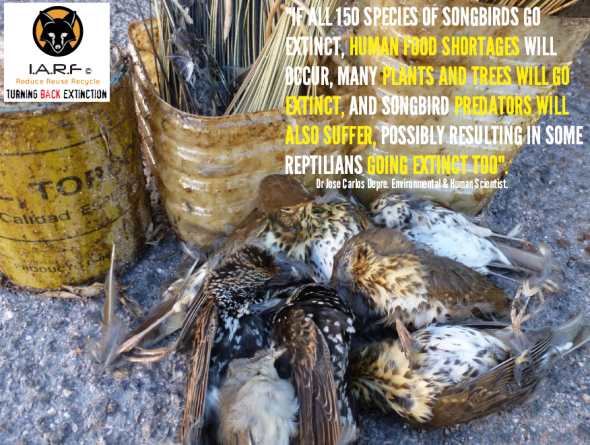
Thank you for reading.
Dr Jose Carlos Depre.
Environmental, Botanical & Human Scientist
PhD. MEnvSc. BSc(Hons) Botany, PhD(NeuroSci) D.V.M.
Vegan Monday | Braised Tofu With Mushrooms Taiwanese Vegan Style.

Vegan Monday | Braised Tofu With Mushrooms Taiwanese Vegan Style.
Every Monday and Friday we release on this site a vegan or vegetarian recipe for hundreds of thousands of readers across the globe during the last six months of the year. Furthermore we also release everyday via our main Facebook page a vegan or veggie recipe. Vegan Monday’s and Fridays are aimed at everyone, to encourage our readers twice a week to at least try a meat free or dairy free diet. We’re not forcing our beliefs or diet whatever you wish to call it onto you, however we’re giving you the option to at least try, and why not?
Today’s environment is heating up and fast. The IPCC (Intergovernmental Panel on Climate Change) has predicted a 2-3oc temperature rise globally come 2050-2100, and the main reason for this rise is due to massive methane and carbon pollutants entering the atmosphere. So we believe its in our interests and, yours to at least try to reduce the effects of climate change by opting for one or two days a week (meat and dairy free)?.
Over the past month we have been asked by many people around the world to provide recipes about tofu, or have been submitted meat recipes to change into meatless recipes. This Monday we’re going back to Asia briefly and next week we’re going to get our hands into some real European vegan and veggie recipes.
BRAISED TOFU WITH MUSHROOMS TAIWANESE STYLE
INGREDIENTS:
- 500g fresh tofu
- 3 colours of peppers (half a pepper of each)
- A stick of celery or two
- Wood ear fungus, a handful
- A cup of dried shitake mushrooms
- One chopped spring onion
- A chili
- A thumb of ginger
- Sauce – 2 tbsp soy sauce and 1 tbsp thick soy sauce, some sesame oil, corn flour and a vegetable stock cube, 2 tsp sugar (please check for palm oil, if added please try to leave out)
- One carrot shredded for topping
- A handful of shredded spinach for topping
INSTRUCTIONS:
Soak the dried mushrooms and wood ear fungus overnight in a cup of water (keep the water for the gravy/sauce).
Cut the tofu into small/medium triangles. Chop up the rest of the ingredients to your liking. In a small bowl make the sauce with the 2 soy sauces and the stock cube, the dried mushroom soaked water and use cornflour to thicken and 2 tsp of sugar. (Please leave the sugar out if catering for diabetics, or children).
Now quick fry all your peppers and celery, for about 20 seconds in hot shallow oil. In the hot pan pour out the oil and add in some sesame oil, just about 2 tbsp. Put the tofu pieces in the hot pan and add a teaspoon of sugar to help the browning. Turn the tofu patiently until all your sides are browned and crispy. For a sugar alternative - please click the link here http://greatist.com/health/30-sugar-substitutes-any-and-every-possible-situation
When it looks ready, push the tofu to the side and add the other vegetables, stir with a bit more oil if you need it, also add a bit of soy sauce. Add the bowl of sauce you made, now braise the whole lot together for a couple of minutes so the sauce flavor combines into the tofu. Optionally add a dash of Worcester sauce and a sprig basil to serve, garnish with grated raw carrot and spinach!
I’m not a fan of tofu, (but that’s my opinion), however when I cooked this last night it was incredibly tasty, and infused with so many different tastes that slowly emit into ones mouth stimulating all the tastes buds, palate and finally brain. The tip is not to overcook these foods, as it will drain the flavor, and you’ll be left with a tasteless goop. You can add like I did sunflower seeds or mixed seeds to the top, and a handful of crushed pistachio. Don’t forget to check the quick and easy recipe out below via the video.
Have a nice day.
Dr Jose C. Depre.
Environmental, Botanical & Human Scientist.
ENJOY
Endangered Species Monday | Potorous gilbertii - Back From The Brink Of Extinction.
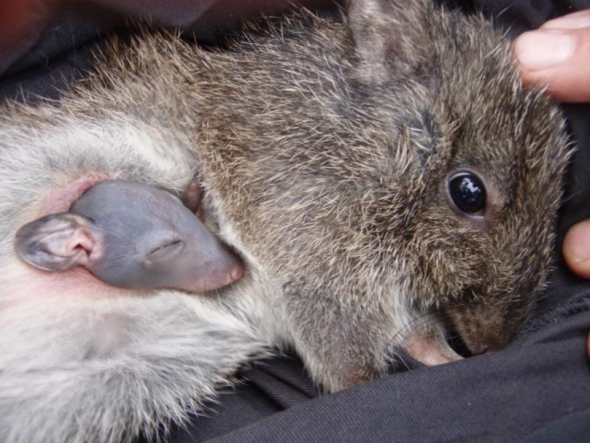
Endangered Species Monday | Potorous gilbertii
This Monday’s (ESP) post, I’ve decided to document a little more on Australia’s wildlife. This Monday I have dedicated this post to one of Australia’s most endangered marsupials. Commonly known as the Gilbert’s Potoroo. (Image Credit Parks and Wildlife Australia).
Identified as the worlds ‘rarest marsupial’, the species is scientifically known as the Potorous gilbertii. Listed as (critically endangered) the species was primarily identified back in 1841 by Dr John Gould FRS - 14 September 1804 – 3 February 1881) who was a British ornithologist and bird artist. He published a number of monographs on birds, illustrated by plates that he produced with the assistance of his wife, Elizabeth Gould, and several other artists including Edward Lear, Henry Constantine Richter, Joseph Wolf and William Matthew Hart.
Dr Gould has been considered the father of bird study in Australia and the Gould League in Australia is named after him. His identification of the birds now nicknamed “Darwin’s finches” played a role in the inception of Darwin’s theory of evolution by natural selection. Gould’s work is referenced in Charles Darwin’s book, On the Origin of Species.
Life hasn’t been at all easy for the P. gilbertii. It was only back in 2012 that conservation and environmental scientists (rediscovered) the species of which it was believed the marsupial had gone completely extinct within the wild. Endemic to Australia there is very little known in relation to when threats came about, increased and decreased. However I can state now; as small as populations are known - P. gilbertii’s populations are ‘currently stable within the wild’.
While though populations are stable, there are only thirty to forty actually known to be living within their endemic wild, so there is still a large amount of concern for the worlds most endangered marsupial. Back in early 1980’s the species had been listed as (completely extinct within the wild after studies from the 1800’s turned up nothing). Fortunately though environmental scientists went on the prowl and were not under any circumstances ready to write this species off whatsoever. They were technically looking for an animal that hadn’t been seen since the 1880’s-1990’s. Their work though eventually paid off.
“THEN CAME A BREAK THROUGH IN 1994”
Environmental scientists come 1992-1993 were ready to write the species off, call off all explorations and projects that were aimed at hopefully rediscovering the species. Fortunately though the Australian Parks and Wildlife Service persisted - and come 1994 a spotting was recorded. After so many years believing the Gilbert’s Potoroo had gone extinct, scientists discovered an extremely small population - to the joy of many. Finally there was hope, and today the species remains under full governmental protection.
Native to South-western and Western Australia the remaining populations was taken by three collectors between 1840 and 1879 in the vicinity of King George’s Sound (Albany), but exact locations are unknown. Skeletal material is common in cave deposits between Cape Leeuwin and Cape Naturaliste. Sub-fossil skeletal specimens have been located in coastal sand dunes between these localities. It is currently restricted to Mt. Gardner promontory in Two Peoples Bay Nature Reserve.
The entire population (consisting of 30-40 mature individuals) as explained above remains inhabits the Two Peoples Bay Nature Reserve of which they enjoy protection from the local parks wildlife board. While populations are identified as extremely small, mother will give birth to either 1-2 babies every year, normally its 2 babies. Like kangaroos the species has the ability to keep a second embryo in a state of diapause while the first embryo is growing. If the first baby does not go to term, a second baby starts growing right away.
Check out the Gilbert’s Potoroo Action Group by clicking this link
Diapause is considered a rare phenomena - especially in kangaroos, although its been witnessed quite a lot over the past few years by European, British and Australian Zoologists. The last diapause event (that I’m aware of) was witnessed at the Taronga Zoological Gardens in Australia. You can read the story >here.< The gestation period for Gilbert’s potoroo is unknown, but is estimated to be similar to the long-nosed potoroo at 38 days.
Since so few are alive today, much of the reproductive cycle for Gilbert’s potoroo remains unknown. However, the main breeding period is thought to be November–December with similar breeding patterns to those of the long-nosed potoroo. Scientists have tried to breed them in captivity, but recent attempts have been unsuccessful, citing diet, incompatibility, and age as possible factors that influenced the lack of reproduction. Reproduction in the wild is thought to be progressing successfully as many females found in the wild are with young.
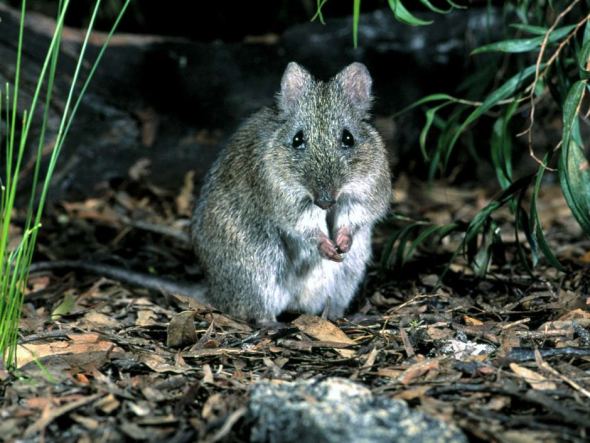
Image: Gilbert’s Potoroo. Photographer Mr Dick Walker.
In 2001, the Gilbert’s Potoroo Action Group was formed to help in the education and public awareness of the potoroo. The group also helps with raising funds for the research and captive-breeding programs for Gilbert’s potoroo. In efforts to protect the remaining population, three Gilbert’s potoroos (one male and two females) were moved to Bald Island in August 2005, where they are free from predation. Since that time, an additional four potoroos have been sent to establish a breeding colony.
THREATS
Fire is the critical threat (present and future) to this species as the Mt. Gardner population is in an area of long unburnt and extremely fire prone vegetation, and a single fire event could potentially wipe out the species (except for the few individuals in captivity and on Bald Island). This species is in the prey size range of both feral cats and foxes, and both are known to exist in the Two Peoples Bay area, thus this species is likely threatened by these predators.
Maxwell et al. (1996) states that the reasons for the decline of the species are unknown. Predation by foxes has probably been significant. Changed fire regimes may have altered habitat and/or exacerbated fox and cat predation by destroying dense cover. Gilbert’s notes record it as “the constant companion” of Quokkas, Setonix brachyurus
Unlike Gilbert’s Potoroo, the Quokka, although declining, persists over much of its pre-settlement range. The difference has not been explained. Maxwell et al. (1996) and Courtenay and Friend (2004), suggest that dieback disease caused by Phytophthora cinnamomi threatens persisting populations by eliminating plant symbionts of hypogeal, mycorrhizal fungi which are the principal food of Gilbert’s Potoroos. Altering vegetation structure and eliminating plants that provide food are direct threats to this species.
For now and based on various accounts, research and up to data documentaries. The species is still in danger. As explained above a single large and sporadic fire within the species habitat - could kill off the entire identified populations, which would be a catastrophe. While there is minimal threat from predators such as foxes and feral cats - this could change. So the need for persistent monitoring is a must. Finally we have disease, with populations being so small at around 30-40, any single disease could like fires wipe the entire species out within a single week.
Within the article above I’ve included various links for your immediate attention and information, as well as a link to the main working group that is helping (and doing all they can) to preserve the species. Furthermore I’ve included a donation link for you to donate to the Gilbert’s Potoroo Action Group. While I’m not entirely sure whether you can volunteer, there is a link on the main website below (highlighted: Volunteer Today). Just click the link, follow the instructions and, I’m confident someone will get back to you as soon as possible.
Volunteer Today
Thank you for reading, please don’t forget after reading to share this article, and hit the like button too.
Dr Jose Carlos Depre Depre PhD. MEnvSc. BSc(Hons) Botany, PhD(NeuroSci) D.V.M.
Environmental & Human Science
Endangered Species Friday | Bubalus mindorensis | Asia’s Next Extinction!
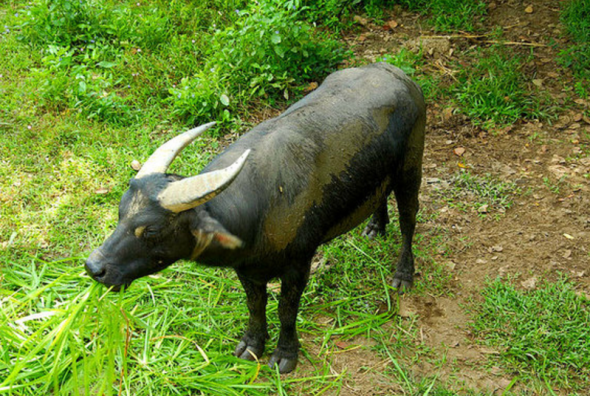
Endangered Species Friday | Bubalus mindorensis
This Friday’s (ESP) Endangered Species Post, I’m touching on a very undocumented species of buffalo that is so endangered - its extremely likely the species will go extinct within the next ten years maximum. (Photographer unidentified).
Listed as (critically endangered) the species was primarily identified back in 1888 by French born Dr Pierre Marie Heude (25 June 1836 – 3 January 1902) whom was a French Jesuit missionary and zoologist. Born at Fougères in the Department of Ille-et-Vilaine, Heude became a Jesuit in 1856 and was ordained to the priesthood in 1867. He went to China in 1868. During the following years, he devoted all his time and energy to the studies of the natural history of Eastern Asia, traveling widely in China and other parts of Eastern Asia.
Endemic to the Philippines B. mindorensis first came to the attention of environmentalists when conservationists began studying the Mindoro Water Buffalo in the early 1940’s of which they found insufficient data relating to the species. Unfortunately from 1986-1996 the species was then suddenly re-listed as (endangered).
Yet the Tamaraw had been known to overseas and native conservation scientists for over THIRTY YEARS of which today we’re now seeing a possible new extinction occurring within the Philippines. How is this possible, when scientists knew about the status of the species, why hasn’t a single zoo removed small populations to house in protective breeding captivity for later reintroduction into the same habitat, or new pastures?
Meanwhile from the year 2000 to 2008 the species was again (re-listed from endangered to critically endangered). Today the Tamaraw is now bordering complete extinction within the wild, and from what we know there is ‘possibly’ no protective captivity projects anywhere around the globe to preserve the species for future reintroduction in the wild. We do hope that we’re wrong?
From what we know based on the last census from 2013 (three years ago) there was noted within the wild only 105 mature individuals remaining. This equates to exactly 105-210 mature individuals (estimate). Within the past three years its very likely we have probably lost half of the remaining populations known, which could mean there is only 52-205 mature individuals remaining within the wild to date.
The species is not known to be fragmented, however populations are still declining. The major threat was once identified as hunting, although ‘allegedly’ isn’t known to be a threat now?. As a scientist and environmental crime CEO I find this very difficult to comprehend, due to the amount of horned ungulates which are being located throughout South East Asia. I must state though: my environmental crimes officers as yet haven’t located any Tamaraw horns or trophy heads.

Image: Tamaraw. Credits: Ruisu Fang.
Formerly, Tamaraw were found across the whole of Mindoro from sea level to the high peaks (to over 1,800 m), inhabiting open grassland or forest glades, thick bamboo-jungle, marshy river valleys, and low to mid-elevation forests. The species is currently confined to a few remote areas over 200 m, and is most often recorded in secondary forest and mixed forest/grassland.
Tamaraw are largely solitary, although females occur with offspring. Males and females occasionally associate temporarily throughout the year, which is similar to other bovines species, such as African buffalo, banteng and gaur. The solitary nature of the species is probably an adaptation to forest habitats, where large groups would prove to be a hindrance. Tamaraw feed primarily on grasses, as well as young bamboo shoots, in open grasslands, resting within tall grasses or dense forest. Although formerly diurnal, Tamaraw have become largely nocturnal due to human encroachment and disturbance.
“WE’RE LOSING THEM, AND FAST”
I do find it quite disheartening to know that the Philippines “national animal symbol” isn’t really being preserved or even protected from nearing complete extinction, although there are some projects out there that are helping to save the species from extinction, the problem is of course, as usual, funding!. One would think that a country that’s so wealthy, and a country that has introduced so many animal, wildlife and environmental laws would at least be fighting to protect the tamaraw. From what I have read and heard from the locals - they are trying their utmost hardest, unfortunately not everyone thinks the same as many kind Filipinos.
THREATS
The main current threat to the Tamaraw is habitat loss due to farming by resettled and local people, with a high human population growth rates in and around its remaining habitat. In some areas, fires set for agriculture are a threat to the species’ habitat. Cattle ranching and farming activities pose a number of threats, including the risk of diseases spreading to the Tamaraw from livestock and burning of pastures leading to a reduced number of palatable grass species.
Historically, Tamaraw were hunted for both subsistence and sport, which led to a period of drastic decline in numbers of individuals and populations. Hunting was carefully regulated prior to World War II, but since then a growing human population, logging operations, ranching, and widespread availability of firearms on Mindoro have caused a dramatic decline in numbers.
Since the 1980s, sport hunting has reduced due to a decline in the Tamaraw population, closure of nearby ranches, and more intensive patrolling and awareness activities since the establishment of the protected area. International trade in this species or its derivatives has not been reported. Although protected by law, the illegal capture and killing of this species continues.
While its currently “illegal to poach or hunt” the species “we believe some are still being poached within the Philippines to provide horns to both China and Viet Nam”. As yet there is NO EVIDENCE to back these claims up, however I.A.R.F.A environmental crimes officers have located in Viet Nam a lot of ‘counterfeit Rhinoceros horn’, which when analysed, has proven to us the horn[s] most certainly aren’t from rhinos, but from a buffalo species. So this area of the counterfeit rhino horn trade still needs intensive investigation.
The current plight of the tamaraw is not looking good, and from our own investigations and third party environmental investigations relating to the species - extinction is very likely to occur in around five to ten years (if that).
“THE TAMARAW IS ASIA’S NEXT EXTINCTION”
Thank you for reading.
Dr Jose Carlos Depre. PhD. MEnvSc. BSc(Hons) Botany, PhD(NeuroSci) D.V.M.
Environmental, Botanical & Human Scientist.
TOREO | THE BULLS STORY - LA FIESTA NACIONAL.
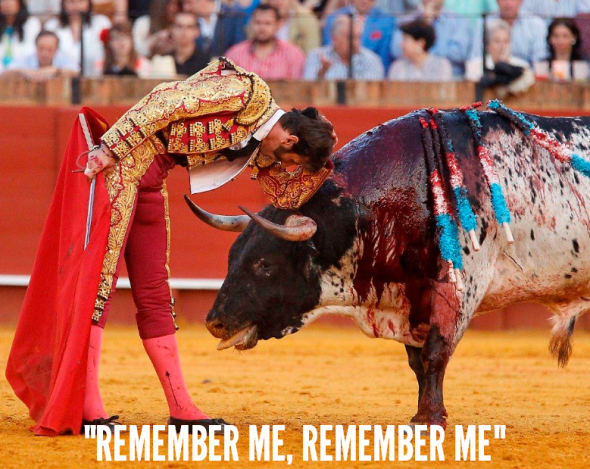
TOREO | THE BULLS STORY
HISTORY
Toreo. Just the word brings back horrific flashbacks of the many times myself and friends working within the Animal Rights Militia have taken on the matadors and their deranged, psychopathic fiends, that revel within this brutal festival. The last account five years ago was when we stormed a bullfighting ring. Not only was we spat at by the crowd, we were also beaten over the head, shoulders, and body - Police deliberately turning their head as pepper was rubbed within our eyes. Water cannons shot at us, female activists chained together with us all screaming as the matadors fiends attacked, welcome to Spain.
That’s the level at which these sadists drop to, just to protect their so called brutal and gory cultural tradition. Police then, after each activists chain was cut, dragged each of us away, before imprisoning each individual for illegal trespass, and various public order offences. Forget the bull though that’s beaten, lanced, and brutally tortured (even before the festival begins). Oh, didn’t you know? What, you thought the bull was only abused during the event? No, far from it. Every single bull before they even enter the bullfighting ring are lanced, they have pepper or Vaseline rubbed within their eyes, and are also stabbed within their genitals just to weaken the bulls strength. The spectators believe that this strong, proud, and daring matador is actually fighting a strong and powerful bull. Far from it!
“Stabbed in the genitals - Vaseline rubbed into the bulls eyes”
Bull fighting in Spanish known as (Toreo) has been a part of Spanish tradition now for many hundreds of years. The “cultural tradition” dates as far back to the 1700’s, which then was a traditional event reserved primarily for the wealthy nobleman. Today the so called tradition is now watched by families both poor and wealthy, children and even celebrities. Today we see a man or woman known as a (matador) standing within the ring taunting and aggravating the bull.
It’s quite uncommon to witness now anything other than the matador within the ring. From the early 1700’s right up to 2008 horses were still used by matadors (and are still used within some events). Unfortunately as one can see within the image below, these forgotten victims (despite the masses armor protecting them) in many cases would be the bulls first victim. But why horses?
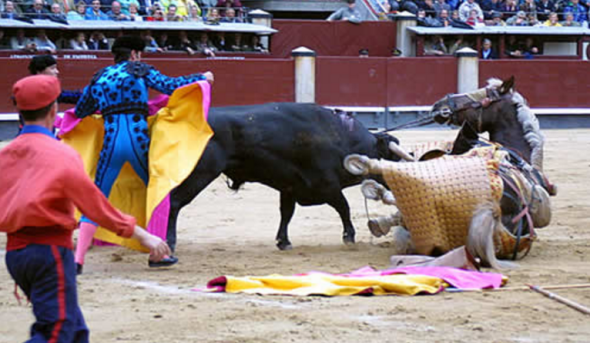
Image: Bull gorges the horse, often in many cases dying from their injures.
The tormented bull does not understand that it is the man on the horse’s back that is causing his pain, only that he is in agony. He therefore sees the horse as his enemy as much as the man. It’s not unusual for horses used in bullfights to be so badly gored by the bulls that they have to be killed, but only after they have been dragged from the ring and the view of the spectators. Spanish bullfights also employ “picadors”, men on horseback armed with spears.
Horses are often the “forgotten victims of the bull fighting tradition”. Rarely are they mentioned within the press, or the media, their pain etched deep within their eyes after the bull gorged them, before yet another sadist fires a bullet into the horses head - killing them instantly releasing them of further misery and pain. What a waste of an animal - all for a so called cultural tradition!
I’ve documented on many bullfights now, however, today, refuse to part with my money just to provide it to sadists. I’ll admit now, even a grown man, hardened by the sights and sounds of animal torture tears were and still are shed, knowing I couldn’t do a single thing to stop this animals pain, witnessing them up close, the pain clearly visible within their eyes, in a sense pleading with me or someone to help them, reminding me in a sense to remember them.
The horses are blind-folded to prevent them from becoming terror stricken at the charge of the bull. It is commonly believed that their ears are stuffed with cotton-wool to prevent them from panicking and their vocal cords cut to stop them screaming with fear at the bull’s attack. This is the fate of these beautiful animals. To be used to entertain a crowd that lusts for blood and claims that bullfighting is a tradition and “cultural heritage”.
“Horses ears are stuffed with cotton-wool to prevent them from panicking and their vocal cords cut to stop them screaming with fear at the bull’s attack”
What about the brave matadors, picadors and their ilk? Bullfighters are rarely injured and seldom killed in the ring. With their armory of weapons to weaken the bull until it can no longer fight, their lives are not at great risk. In fact, in the last 50 years only 10 bullfighters have been killed worldwide. The last gimp that was gored by a bull and killed was back in July 2016, identified as Victor Barrio. In my humble opinion his death wasn’t gory enough, and I’d have quite happily paid good money knowing he was going to be gored to death slowly and sadistically just to send my love as he departs this grotesque and evil world to hell.
Many people believe that bullfighting is only confined to Spain, if only? Bull fighting is hosted in various countries around the planet - mostly European. Spain, Portugal and France are the main three European countries where bull fighting is still legal - although in France activists are fighting back hard, and I do believe that France is soon to kick this horrifying cultural tradition out off the back door for good. India, United States of America, and Tanzania all host bull fighting events too. Furthermore in India, Persian Gulf, Japan, South East Asia, South Africa, and Kenya host “bull wrestling events”, again the bull is brutally killed.
Building of the Maestranza Bullring in Seville began in 1758 making it Spain’s oldest Plaza de Toros. The origin of modern day bullfighting on foot (rather than horseback) can be traced back to Ronda. It is one of the most charming bullrings in the country and although its capacity is only 12,500, it attracts the top bullfighters. You can see bullfights in Seville from April (during Seville’s Feria de Abril) through to October. The video below is one on of the most barbaric so called “cultural traditions” I’ve ever witnessed!
“THIS IS SPANISH CULTURE”
LA FIESTA NACIONAL
The Spanish bullfighting season is normally hosted from April into October every year. However within the past decade activists have finally had enough - and today its not uncommon to see activists, and the (locals that support this so called “cultural tradition” facing off with one another within the streets). Violent clashes are at times known to explode outside of the ring and within the ring. The whole purpose of these clashes is to disrupt the event and reduce as many “paying spectators” from gaining access. The more financial disruption can be caused - the quicker these events slowly, but surely come to an end. Please view the video below.
Many spectators that attend the local Spanish bullfighting festivals only witness what is ongoing in the ring before, and after. They are rarely (if at all told) how the bull is acquired, what happen’s to the bull before the festival, and if the bull is lucky - what happen’s to the bull after? I myself believe that if all of these spectators truly knew what happened prior, during and after they’d never attend another bullfighting festival again.
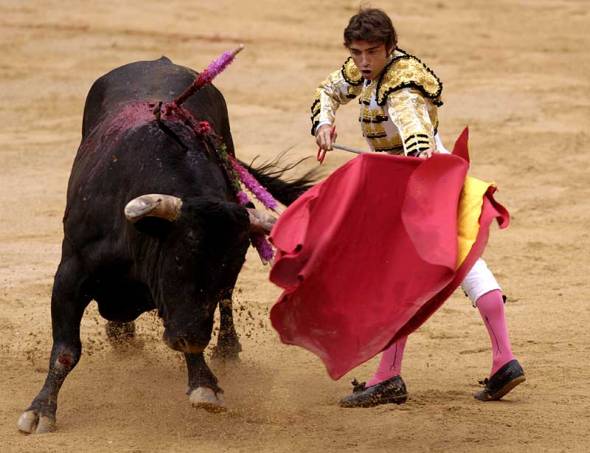
Image: Matador begins preparation for the kill.
As explained above most if not all spectators only witness the bullfighting match; well if you’re one of them spectators (reading this article) then now is the time to read the following gruesome and rather upsetting facts - just so you know how cowardly this so called cultural tradition truly is!.
PRE-FIGHT
The bull is not an aggressive animal (nor does his charge at seeing red), and the reason he is angry and attempts to charge at the matador whilst in the bullring is mainly because he has been horrendously abused for the previous two days. In fact, what spectators see is not a normal, healthy bull, but a weakened, half-blinded and mentally destroyed version, whose chances of harming his tormentors is virtually nil. The bull has wet newspapers stuffed into his ears; Vaseline is rubbed into his eyes to blur his vision; cotton is stuffed up his nostrils to cut off his respiration and a needle or knife is stuck into his genitals.
“The bull has wet newspapers stuffed into his ears; Vaseline is rubbed into his eyes to blur his vision; cotton is stuffed up his nostrils to cut off his respiration and a needle or knife is stuck into his genitals”
Also, a strong caustic solution is rubbed onto his legs which throws him off balance. This also keeps him from lying down on the ground. In addition to this, drugs are administered to pep him up or slow him down, and strong laxatives are added to his feed to further incapacitate him. He is kept in a dark box for a couple of days before he faces the ring: the purpose of this is to disorientate him. When he is let out of the box, he runs desperately towards the light at the end of the tunnel. He thinks that at last his suffering is over and he is being set free — instead, he runs into the bullring to face his killers and a jeering mob.
“A strong caustic solution is rubbed onto his legs which throws him off balance”
THE BULL FIGHT
The above “pre fight description is 100% factual” - I’ve seen it with my own eyes, and have spoken to various ex-matadors (that also verify mine and others claims) that are now friends with myself - fighting to end this gruesome cultural tradition. Furthermore its not just the bulls that are abused, as explained above, horses are treated in more or less the same horrifying manners.
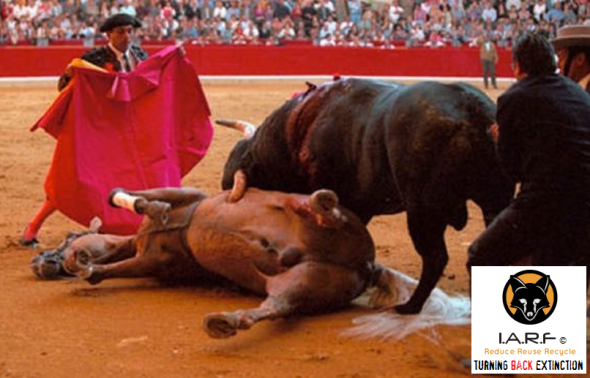
Image: Frightened horse - gored and unfortunately killed.
Strictly speaking, a bullfight is composed of 3 separate “acts”, and the whole thing is supposed to last for 20 minutes, though in actual fact it varies. The opening of a bullfight begins with a tune being played on a trumpet — the tune is the special, signa lure Rifle which characterises the beginning of the horror. Upon entering the ring, bulls have been known to collapse through exhaustion alter their pre-fight ordeal — they have been dragged to their feet by the bullfighter’s assistants. Below is a video of the “forgotten victims” - horses. The video I believe was recorded in Peru or Mexico.
THE PICADORS
The sequence of events begins when the bull faces the picadors — these are the men on horseback, whose purpose it is to exhaust the bull. They cut into his neck muscles with a pica. This is a weapon of about 6-8 inches long, and 2 inches thick. Once it is thrust into the bull it is twisted round and a large, gaping wound appears. The bull then starts bleeding to death. But why can’t the matador do this - a man that is so strong, so fearless and is scared of no beast? Well its simple. The matador requires the help of three to four other gimps because there is no way he’d safely be able to deliver that first blow thus weakening the bull as he (cowardly attacks the animal). Isn’t that how bullies in the school playing field behave? The image below depicts various weapons and a pica - a rather crude weapon that the picadors use to weaken the bulls strength, so the coward in woman’s clothes can take the bull down with ease.
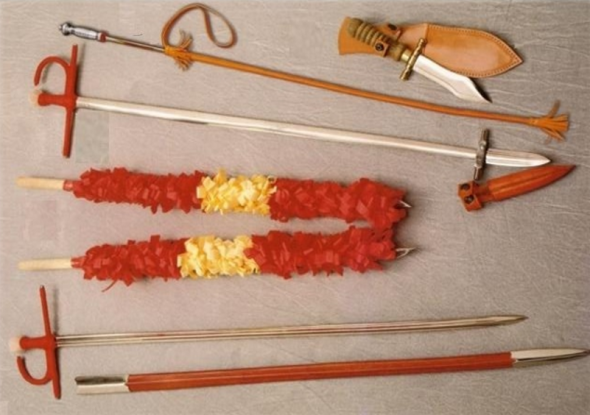
Image: Pica and Banderilla.
Pica’s and Banderilla’s vary in shape and size, there really isn’t any specific shape although most picadors will tend to chose a slim, and sharp pica or Banderilla, so as to not quicken the loss of blood from the bull. Furthermore the slimmer and finer the blade - the easier it is to stab into the bull. The last thing a picador wants is to be battling within an already pissed off bull that could take the horse down (which it does sometimes) and potentially kill the picador too. The above image is an example relating to the bladed weapons used by picadors, and matadors.
ASSISTANT MATADORS
After the picador has finished his sordid and rather sick, perverted business, the assistant matadors then get to work with the banderillas (sharp, harpoon-like barbed instruments seen in the image above). These are plunged into the bull’s body, and he may also be taunted by capes (seen in the image below). Up to six banderillas may be used. When the banderillas strike the bull stops in his tracks and bellows madly.
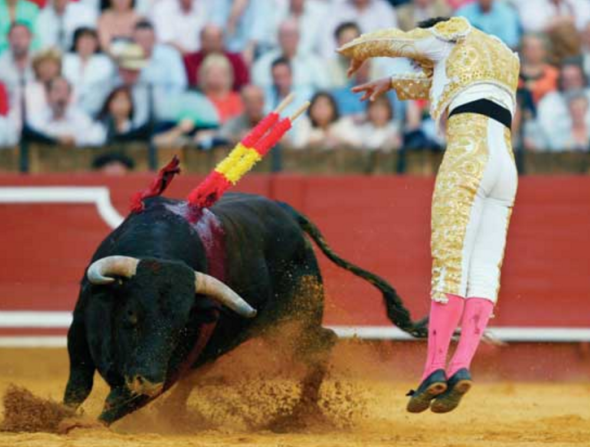
Image: Matador plunges Banderilla into bull.
THE FINAL ACT OF BARBARITY
A trumpet signals the final “act” — in fact, during the whole nightmare, strange, slow tunes are played throughout. It is, of course, during the final act that the bull is killed (and hopefully goes onto a better life). The kill should last 6 minutes, and is done by the main matador. If he has any difficulties (which is an extremely rare occurrence), the others immediately rush in to his aid and finish off the bull. While death may take some 6 minutes - brain death takes over 30 minutes if not longer.
THE FINAL DEGRADATION
The matador is supposed to sever the artery near the heart with one thrust of the sword — in fact, this never happens. It often takes 2-3 times before the creature is mercifully released by death. By this time, the bull’s lungs and heart will be punctured and he always vomits blood. Miraculously, he sometimes attempts to rise again, and gets up on his knees, only to receive further mutilation at the hands of his tormentors. He finally gives up, goes to his knees and lies down. Even then, he is not allowed a little dignity to leave this world in peace, his ears and tail are cut off (often when he is fully conscious), and his broken, bleeding body is dragged around the ring by mules, to which he is attached by an apparatus made of wood and chains. Not content with his suffering, which must be too horrible to describe by words, the crowds boo and jeer him. They even throw empty beer cans at him. His body is then taken away to be skinned, and even then he may not be dead when this happens.
“THIS IS SPANISH CULTURE?”
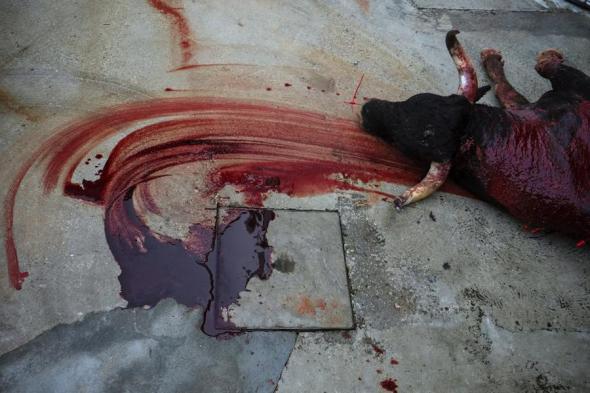
Image: Bull is dragged away after being brutally and sadistically killed.
THE JUDGES FINAL DECISION
To be brutally honest I don’t really know what’s worse. Watching the matador or picadors rain merry hell down on the bull, the bull vomiting blood, and suffocating on its own blood, the bull collapsing to his feet unable to take a further onslaught, or the judges final decision on how the fight went?. Once the bull has collapsed and begins the slow several minutes of painful death. Judges will rule on how well the matador fought. Traditionally when the bull is down and unconscious, judges will decide whether to cut off one ear (for a good fight), two sliced ears means (an excellent fight), or two ears and the tail (bravo - the best fight they’ve witnessed).
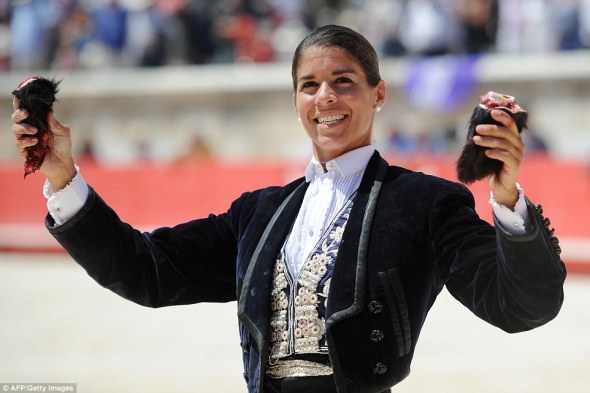
Image: Female Matador Lea Vicens sliced the two ears off (excellent fight).
IF THE BULL GORES THE MATADOR TO DEATH?
When I posted about Victor Barrio’s death, many people reveled about his death, cheered the bull, while many more truly believed that was it, the bull had won, and that was that. Unfortunately within Spanish tradition that’s not how this so called “culture” concludes matters. Bulls are bred by the local farmers, of which the farmer will chose the very best bull to enter the ring. 100% of all bulls that the local farmer will be presenting to the ring - are 100% free roaming and wild. So you’d kind of think, that should the bull get lucky the bull will be returned back to the farmer and treated by a veterinarian, and hailed as an animal hero? Think again! Feel free to leave Lea Vicens a message on Facebook here
Far from it. The bull hasn’t a chance. Its either take the matador on and lose - of which the bull is then skinned and fed to the locals, or take the matador on and kill the matador, of which unfortunately the bull will still die. Those lucky bulls that (incredibly rarely) are able to take the matador down and kill him or her, will be sent to slaughter. As an environmental and human scientist and qualified veterinarian I find the latter quite mindbogglingly odd. Should a bull win or even lose that’s been scared witless, put through hell, of which its body has been pumped with stress hormones and adrenaline prior and during the battle. That meat will be toxic and tough to eat. So in a sense the bull is (if they win or lose) getting their own back on the local community either way!.
THE BULL ALWAYS HAS THE LAST LAUGH
Stress, fear and pain when animals are being slaughtered or waiting to be slaughtered results in several disease processes in the humans which eat the meat. Most notable are cardiac problems, impotency and general fatigue. These adverse effects are most directly associated with consumption of dog meat (simply because there is no dog meat slaughter regulation - and in this case with the bull that wins or loses - no regulation on disease neither). Experiments including laboratory dogs slaughtered in stressful conditions result in impotence of rats fed with the dog’s meat. These results correlate with studies of humans in St. Georges, Utah.
Studies made of domestic farm animals (cattle, pigs and poultry), and of laboratory animals (dogs and rats) show in all cases elevated levels of steroid hormones, generally associated with adrenocortical secretions. Primary substances include adrenaline, cortisone-like secretions, and steroids which stimulate fear pheromone production. All of these are known to result in poor health and poor vitality. This study confirms this link in food consumed by humans.
I’ve studied human, wildlife, botanical and environmental science for many, many years. I’ve written over 4,000 articles for press and the media and talked on radio shows within the past decade around the globe. However during all of these articles, including my own organisations articles I’ve never written about such barbaric, repulsive, and backwards so called cultural traditions. Nevertheless - and regardless of how long these so called cultural traditions continue I and my fellow companions as well as the media and press will continue to fight on to end this barbarism.
Five years ago I looked into a bulls eyes and cried my heart out watching the bastard matador slowly and sadistically kill the bull in front of me and many hundreds of jeering spectators. I felt in a sense that the bull was asking me to remember him, and as yet been unable to explain that story in full. So this time I’ve remembered him, released that horrific memory from my mind. I’ve told his side of the story - a story that is rarely told to the witnessing public. Remember him I damn well did. I’ll never forget neither.
Thank you for reading, and to follow my of my articles stay tuned to my main site >here<
Dr Jose C. Depre PhD. MEnvSc. BSc(Hons) Botany, PhD(NeuroSci) D.V.M.
Environmental, Botanical & Human Scientist.
Chief Executive Officer | Chief Environmental Crimes Officer.
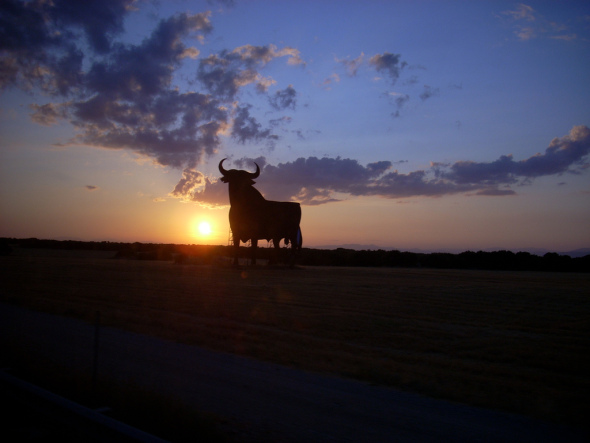
Endangered Species Monday | Heteroglaux blewitti - Extinction is now Imminent.
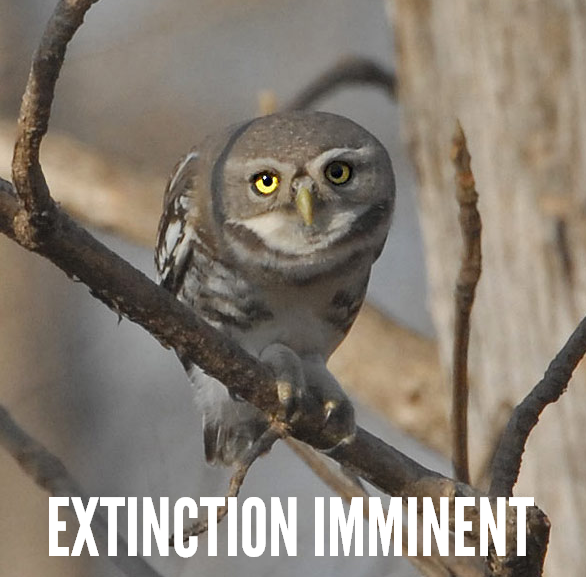
Endangered Species Monday | Heteroglaux blewitti - Extinction is now Imminent
This Mondays (ESP) article (Endangered Species Article), I am am documenting yet again on a species of forest owl (being the third time). This time I know for sure the species is going to go extinct - and sadly there is little that can be done to preserve the bird, although environmentalists are still battling, unfortunately it’s not looking good at all. (Image Credit: Birds of the Bible for Kids).
Listed as (critically endangered), the species was identified back in 1873 by Dr Allan Octavian Hume CB (6 June 1829 – 31 July 1912) was a civil servant, political reformer, ornithologist and botanist who worked in British India. He was one of the founders of the Indian National Congress, a political party that was later to lead in the Indian independence movement. A notable ornithologist, Dr Hume has been called “the Father of Indian Ornithology” and, by those who found him dogmatic, “the Pope of Indian ornithology.”
As an administrator of Etawah, he saw the Indian Rebellion of 1857 as a result of misgovernance and made great efforts to improve the lives of the common people. The district of Etawah was among the first to be returned to normalcy and over the next few years Dr Hume’s reforms led to the district being considered a model of development. Dr Hume rose in the ranks of the Indian Civil Service but like his father Joseph Hume, the radical MP, he was bold and outspoken in questioning British policies in India.
He rose in 1871 to the position of secretary to the Department of Revenue, Agriculture, and Commerce under Lord Mayo. His criticism of Lord Lytton however led to his removal from the Secretariat in 1879. Back in 1988 the Forest Spotted Owlet was listed by environmentalists as threatened. Unfortunately since the 1980’s habitat destruction, poaching, deforestation and gradual human population increases have skyrocketed.
“CONTRADICTIONS”
Conservationists allegedly from 1994-2012 battled hard to preserve the species of Spotted Owlet, regrettably their battles have been lost. Back in 2013 a further census was undertaken of which proved the species was nearing complete extinction within the wild. Today (2016) its incredibly likely we’ll lose the Spotted Owlet from all of its range.
Endemic only to India there is estimated to be (from the last census of 2013) a depressing total of 50-260 mature individuals remaining. The total number of “sub-populations has been identified as 2-100. Furthermore within the past ten years from 2006-2016 there has a been “ALLEGEDLY” a continuous population decrease of exactly 10%-19%. International Animal Rescue Foundation India has also reported within the past four years that “very small populations known are still decreasing”, and from records kept the species is highly likely to be extinct within the next 730 days, which is exactly two years.
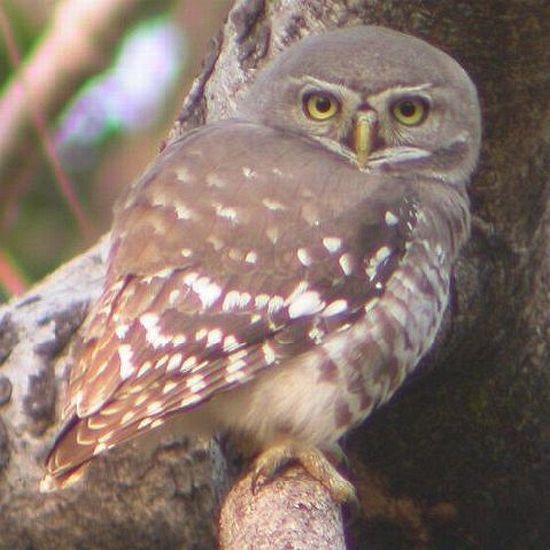
Image credit: Ashley Banwell / World Birders
The International Union for the Conservation of Nature RED LIST have ‘deliberately lied’ and ‘misinformed the general public’ stating the the bird listed hereto was extant from the years of 1988-1996. Conservationists from International Animal Rescue Foundation India in New Delhi hasn’t no reports from 1988-1996 because the bird was only re-discovered in 1997 after it was described in 1873, and it was not seen after 1884 and considered extinct until it was rediscovered 113 years later in 1997 by Pamela Rasmussen. Source: Ripley, S. D. (1976). “Reconsideration of Athene blewitti (Hume).”. J. Bombay Nat. Hist. Soc. 73: 1–4.
So whatever the IUCN are talking about is either codswallop or deliberate misinformation to garner further donations from the public?. I mean how on earth can one make this absurd lie up? Maybe the IUCN can produce documented evidence that proves the species has been active from the 1980’s to 1997? I highly doubt that they can, furthermore this lie (among many more) also brings into question any other lies the organisation “may have been publishing within the public domain” to misinform the general public?
Moving on - the population is estimated (as explained) to number 50-249 mature individuals based on the number of records from known sites, with c. 100 individuals now recorded from Melghat Tiger Reserve. This estimate is equivalent to 75-374 individuals in total, rounded here to 70-400 individuals. Given the increasing number of records and sites known within its range it may prove to be more common than previous evidence has suggested.
Trend Justification: The species faces a number of threats which in combination are suspected to be causing a decline at a rate of 10-19% over ten years.
THREATS
Listed on CITES APPENDIX I (The highest listing) meaning all hunting, poaching and any trade of this species is strictly forbidden (unless otherwise stated). Given its rarity, identification of threats is difficult. Forest in its range is being lost and degraded by illegal tree cutting for firewood and timber, and encroachment for cultivation, grazing and settlements, as well as forest fires and minor irrigation dams.
The site of its initial discovery in 1872 (Chhattisgarh) has completely been encroached by agriculture. Large areas of forest in the Yawal Wildlife Sanctuary and Yawal Forest Division as well as the Aner Wildlife Sanctuary and the Satpuda mountain ranges in Maharashtra have recently been subject to encroachment leading to habitat loss for this species.
It is likely that other forest areas where it occurs are under similarly intense pressure. Overgrazing by cattle may reduce habitat suitability. The proposed Upper Tapi Irrigation Project threatens 244 ha of prime habitat used by the species. It suffers predation from a number of native raptors, limiting productivity, and it faces competition for a limited number of nesting cavities.
The species is hunted by local people and body parts and eggs are used for local customs, such as the making of drums. Pesticides and rodenticides are used to an unknown degree within its range and may pose an additional threat.
These owls typically hunt from perches where they sit still and wait for prey. When perched they flick their tails from side to side rapidly and more excitedly when prey is being chased. It was observed in one study that nearly 60% of prey were lizards (including skinks), 15% rodents, 2% birds and the remaining invertebrates and frogs. When nesting the male hunted and fed the female at nest and the young were fed by the female.
The young fledge after 30–32 days. The peak courtship season is in January to February during which time they are very responsive to call playback with a mixture of song and territorial calls. They appear to be strongly diurnal although not very active after 10 AM, often hunting during daytime. On cold winter mornings they bask on the tops of tall trees. Filial cannibalism by males has been observed.
Thank you for reading.
Dr Jose Carlos Depre - PhD. MEnvSc. BSc(Hons) Botany, PhD(NeuroSci) D.V.M.
Environmental, Botanical & Human Scientist.
www.speakupforthevoiceless.org
THE LIFE OF A COW | THE HORRIFIC TRUTH ABOUT DAIRY FARMING.
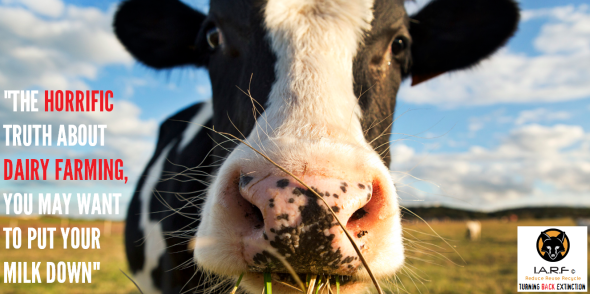
THE HORRIFIC TRUTH ABOUT DAIRY FARMING
Firstly I’d just like to explain, this is the very first article I’ve written in relation to “animal rights”. 100% of my articles are based on nothing but conservation and environmentalism. However I cannot any-longer ignore this side of animal welfare or rights; finally there is only one person that inspired me to write this article, and from listening to that individual, reading and the viewing footage which that individual sent to me. It has led me to investigate this side of animal welfare and agriculture more.
The dairy industry is horrific, something that many people are unaware of, or are aware yet chose to ignore the sadistic industry, because after all its just an animal. I think that’s the depressing side of things, when people chose to believe that an animal is a mere commodity, nothing more and nothing less. I have been a “vegetarian and vegan” now for well over thirty years, unfortunately my main weakness was milk. It was only back in September (2015) that I eventually soon after started to decrease my milk consumption. Today milk is no longer part of my diet, so I guess I’m 100% vegan, in reality there is no such thing as 100% veganism.
GLOBAL MILK PRODUCTION:
There are over 264 million dairy cows worldwide, producing nearly 600 million tonnes of milk every year (source FAOstat). The global average for milk production is approximately 2,200 litres per cow (source FAOstat 2012). That’s a lot of cows, moreover that’s a staggering amount of abuse too. The largest producer of milk is the USA producing over 87 million tonnes per annum (source FAOstat 2012). India has the greatest number of dairy cows in the world with over 40 million cows. The Americas produce 29% of the globes milk, Asia comes in at 21%, Europe 42%, Oceania 4%, and Africa 4%. I find it rather interesting that Africa being “one of the largest continents” on the planet produces only 4% of the globes milk production.
TOP TEN DAIRY COMPANIES:
Despite so many articles, videos and accounts of dairy trade abuse - many companies out there sill insist on being part of this horrifying trade. The top ten companies that “in my opinion fuel this slavery and nefarious trade” are listed hereto: Nestle (29.50 billion USD), Danone (14.79 billion USD), Lactalis (12.68 billion USD), FrieslandCampina (11.17 billion USD), Fonterra (10.20 billion USD), Dean Foods (9.74 billion USD), Arla Foods (8.64 billion USD), Dairy Farmers of America (8.10 billion USD), Kraft Foods (6.79 billion USD), and finally Unilever (6.38 billion USD). All ten international renowned companies are household names, especially Nestle of which its products are sold in literally ever country around the globe from chocolate bars, milk, dried milk and other confectionery.
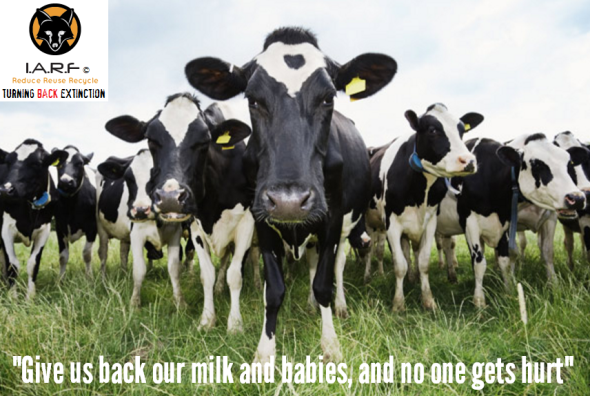
HOW MANY PEOPLE DRINK MILK?:
The global average of whole milk consumption in 2007 was 50kg/capita/yr, the average for cheese was 2.84kg/capita/yr and for butter was 1.32kg/capita/yr (Source: FAOstat). So that kind of (in a mathematical perspective) equates to a staggering amount of milk consumption globally. White people are the biggest milk consumers at some 27.9%, black people 5.2%, and finally Hispanic 9.9%. In all throughout the world, there are more than six billion consumers of milk and dairy products. Over 750 million people live within dairy farming households. Source: http://www.fao.org/docrep/012/i1522e/i1522e00.pdf
That’s a staggering amount of cows that are bred at quite a young age just to produce milk, cheese, butter and other dairy products. Furthermore many people around the world are actually allergic to anything that is “dairy”, some know they are lactose intolerant, while others don’t know and put it down to stomach problems, Irritable Bowel Syndrome, or just gastroenteritis. Overall, about 75 percent of the world’s population, including 25 percent of those in the U.S., lose their lactase enzymes after weaning. The recognition of this fact has resulted in an important change in terminology: Those who could not digest milk were once called “lactose intolerant” or “lactase deficient.”
Virtually all infants and young children have the lactase enzymes that split lactose into glucose and galactose, which can then be absorbed into the bloodstream. Prior to the mid-1960s, most American health professionals believed that these enzymes were present in nearly all adults as well. When researchers tested various ethnic groups for their ability to digest lactose, however, their findings proved otherwise. Approximately 70 percent of African Americans, 90 percent of Asian Americans, 53 percent of Mexican Americans, and 74 percent of Native Americans were lactose intolerant.
1-4 Studies showed that a substantial reduction in lactase activity is also common among those whose ancestry is African, Asian, Native American, Arab, Jewish, Hispanic, Italian, French or Greek. So if you find that after drinking a milky cup of coffee or tea in the morning results in you soon after needing to pass a stool on the toilet, or you suffer gurgling (medical term: borborygmus) within the small and large intestine - its quite likely you are suffering from lactose intolerance. Source: http://www.pcrm.org/health/diets/vegdiets/what-is-lactose-intolerance
HOW IS MILK HARVESTED?:
Many people I’ve questioned over the course of the past six months actually believe both male and female cows produce milk, live happily within a field, and after milking - the cows are kindly (humanely) returned back to the field and all is well. Unfortunately that’s not the case. Ask yourself this question, which is the only species of human that can produce milk, and how is that possible? The answer is simple, the female human is the only human that can produce milk, and for that to happen she must either agree to sexual intercourse to become pregnant, or she is raped, impregnated, and then as explained above - milk is produced nearing the last trimesters of gestation.
So no, male cows (known as bulls) don’t produce milk, only female cows (like female humans) produce milk. A cow is pregnant for approximately 283 days, and produces only one calf. That calf if they are female cannot produce milk at a young age neither - of which they’re known as a “heifer”. Now you’re probably wondering how on earth is it possible for the farming community to continue to keep up with “dairy demand” when a staggering near (six billion consume milk and dairy products, and a single cow is pregnant for 283 days?).
Well being as blunt as I possibly can, and to the point; once the female cow gives birth, the cow is then impregnated again, however farmers cannot wait for a bull to mate with the female cow in most cases, (and for the cow to produce milk once a year she must be pregnant every year too). You may now want to stop eating, and drinking your milky cup of coffee. There are various methods used to “extract sperm from the male bull”. Back in the old days farmers used take the bulls three foot long penises and then masturbate them into a sterile collection jar. Sounds lovely doesn’t it? No it doesn’t!. Source: http://www.independent.co.uk/news/uk/home-news/bulls-semen-10-things-you-didnt-know-1336150.html
Today various collection methods vary in regards to sperm extraction. Some bulls mount frames covered in cowskin and ejaculate into rubber tubes with bottles on the end. Some mount other males, known as “teasers”, only to be interrupted at the crucial moment (which arrives quickly and is over even more quickly) by a man with a rubber tube. Other bulls mount and inseminate females in the natural way, and the semen is then extracted from the cow. When necessary, the bull can be excited artificially, with the help of an aerosol spray which reproduces the smell of a cow on heat. So I guess in a way (this could be seen as sexual abuse of a cow just to provide you with milk, butter, cheese and other dairy products). However its not if we look at it on a “scientific and veterinary medical angle”. I personally though wouldn’t want some strange man jacking me off, would you? …Anyway
…Meanwhile once the farmer or “cow boys” have collected enough semen, this semen is soon injected into the female cow soon after the female cow has given birth. The cow isn’t even given a rest, or a time to recover from her childbirth ordeal. Furthermore the most upsetting part of this trade is when the little one is soon taken away from mother to be killed for the production of “veal”. What you may have believed were happy humanely treated milking cows wandering lazily within the local field - are actually raped cows, used as sex and milk production machines [aka slaves], every year they are forced to breed by humans to provide to some 6 billion dairy consumers - milk!.
Farmers will keep some of the young depending on how many males and females they are holding on their farm. If they are female and some of the elder female cows are nearing their life-cycle of milk production, the elder female cows will be slaughtered, and fed back into the human food chain. So what you may be eating (in the way of healthy and fresh beef) is actually, and mostly overworked milking cows that have been repeatedly raped, or to be scientifically correct “artificially inseminated time again”. Did the cow agree though, did she want to be impregnated again?
Well, think about it, if you was a mother would you want your partner jacking off over you, inside of you or fuc**** you again just to produce more children and milk? No, I didn’t think so. Anyway as explained some of the female and male babies will be kept to keep milk production continuing, unfortunately many will be slaughtered soon after birth, often leaving mother in distress, crying and pining for her little one; and in some rather distressing images I’ve seen on farms, I’ve witnessed mothers chasing after her baby as the farmer abducts her young. That sight almost finished my career within Environmental Science and animal welfare. Furthermore the sight of a maternal cow pining and watching her new born being taking away (for veal production) is pretty traumatic for the cow too.
WHAT HAPPENS TO THE BABY COW:
Firstly veal is the “meat of baby cows” produced mostly from overworked milking cows. Every-year when mother gives birth after 280 days she has to go through the whole ordeal of watching her little one (either male or female) abducted from her (just to provide you with either veal or milk). Pretty horrifying don’t you think? Veal cows are seen as the “surplus of the milking and dairy farming industry”. Baby will be taken away from her mother either a few hours after birth, or a few days after. Source: http://www.whitelies.org.uk/animal-welfare/fate-calves I’m not going to lie, or propagate some melodramatic nonsense, on some farms veal cows will be kept with their mother for longer than a week, that’s about it. The longer the veal cow stays with mother, the more the milk production cycle will be interrupted.
So as your drinking your milk you may want to remember your milk or dairy product has a further added death to it. A baby calf, abducted from the mother, and held within a veal crate (as seen in the image below).
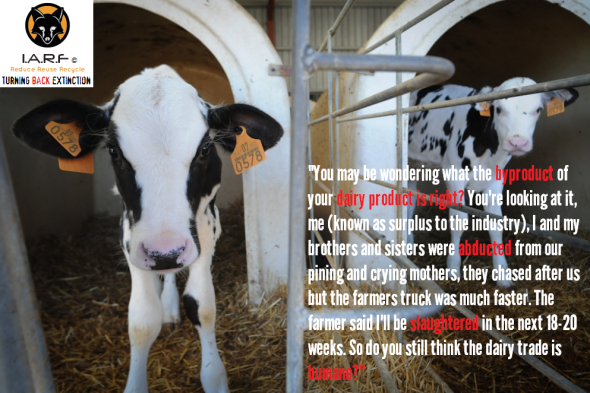
Now as an Environmental, Botanical and Human Scientist I tend to keep away from over exaggerated facts and conspiracies, and the reason I do that is because within Environmental and Human Science if we don’t explain the facts as they are, or provide incorrect and non-factual data, once the public find out otherwise - we’ll rarely be believed or taken seriously again. The image above is 100% factual. Veal cows are seen as (surplus to the dairy and/or farming industry). Veal cows as explained (which you can read in the link above too), are removed from their mothers some hours, a few days or a week after mother has given birth.
From there the veal cows are then held in a veal crate or pen as seen in the image above. In some countries cruel and inhumane veal crates have been outlawed, unfortunately in other countries, they are still being used. You may want to check with your local agricultural ministry in your own county to see if crates are banned or not. The above image is a veal pen, from which baby who’ll be wanting to know where mummy is, and wanting to live like a baby cow will unfortunately be slaughtered for veal meat come 18-20 weeks.
This can be stopped though. How? Quit consuming dairy products, after all 75% of the globes population are actually “lactose intolerance”. Why hurt yourself more, mother and the wee baby? Meanwhile if you’re wondering what a veal crate is, please do watch the video below to understand more on this area of horrific and brutally barbaric agriculture trade just to provide you with milk, cheese, and butter (among other things). The video below originates from a Mercy for Animals undercover investigation in relation to veal farming and the abuse handed out to the little babies. You may find this video upsetting, however it must be shown for you to understand.
WHAT HAPPENS TO ADULT COWS ONCE THEY’VE EXCEEDED THEIR MILK CYCLE?:
To be brutally honest I don’t know what’s more traumatic. Knowing a male bull will be masturbated or excited to produce sperm for insemination and (milk production), a female cow continuously raped every 280 days to produce a new born just for milk to be extracted from the mother for humans; or knowing her wee one is abducted, held within a crate or pen, and killed after 18-20 weeks. There really isn’t a specific traumatic feeling, each and every action is equally as horrifying as one another. The entire dairy industry is sadistic and cruel to the core.
Milk production declines steadily afterwards, until, at about 305 days after calving, the cow is ‘dried off’, and milking ceases. About sixty days later, one year after the birth of her previous calf, a cow will calve again. High production cows are more difficult to breed at a one-year interval.
From THIRTEEN MONTHS (that’s thirteen months) after the female cow has been picked for milk production (and not veal) the primary stages of milking production will begin, meaning that at 13 months the female cow will be artificially inseminated or mated with a bull. The older the cow the poorer milk production is, and lower quality too. Farmers (technically speaking) like their brides young (so to say and excuse the pun).
Domestic cows can live for up to 20 years; however, those raised for dairy rarely live that long, as the average cow is removed from the dairy herd around age four and marketed for beef. So after (four years of being raped time again, and witnessing her young being abducted), four years later she is (after complete exhaustion), killed for meat. So technically and scientifically speaking - when a supermarket advertises fine cuts of beef, healthy beef, or fresh beef - what you may actually be consuming in most cases (as explained above), is in fact overworked milking cows. I often believe when witnessing these adverts on television - its a complete violation of the trades description act.

In 2014, approximately 9.5% of the cattle slaughtered in the U.S. were culled dairy cows: cows that can no longer be seen as an economic asset to the dairy farm. These animals may be sold due to reproductive problems or common diseases of milk cows such as mastitis and lameness. Mmm yummy, beef that is filled with diseases, and reproductive problems. But hey, don’t take my word for it. Look up the links too. Source: http://animaldiversity.org/site/accounts/information/Bos_taurus.html Source: http://livestocktrail.illinois.edu/dairynet/paperdisplay.cfm?contentid=354
So that’s basically the life of a dairy cow and her baby; short, overworked, raised in quite abusive and unnatural environments that aren’t projected into the public domain. Often we see images of farmers with happy faces and cows looking incredibly healthy. These images though are what the agricultural and supermarket industry want to project - because it brings in the customer, it sees money parted, products purchased and the longer that trade and false advertising goes on, the longer cows within the dairy, veal and meat industry will be abused moreover.
Its barbaric, horrific, and if the truth was shown within supermarkets and on the television (such as the video below). I can guarantee now that many people would be most certainly put off from buying anything dairy, or eating anything “beef related”. So I question you now: With your cup of milky tea, coffee, your cheese, butter or anything that is dairy related, would you after seeing this video below still consume “dairy or beef products”?.
Watch how the farmer carefully coaxes the little baby away from his mother. Mother is walking in front, while the little day old bay carefully plods along. Motherly and maternal instinct being played out UNTIL. Baby is snatched away. Watch the behavior of mother cow, she tries to save the little one, somewhat alarmed as to why a human is now taking her baby, she follows the farmer wondering where her little one is being taken, she even runs behind the car with little baby in (that is incredibly traumatic and often leaves the cow emotionally distressed for days or weeks on end. Are you still thinking of drinking that milk, or are you going to throw it away and think of a more humane and non-cruel option?).
DO COWS SUFFER FROM PSYCHOLOGICAL TRAUMA WHEN BABY IS REMOVED?:
Many people never realize that ‘animal maternal mothers’ go through the same feelings, and behave the same as ‘human maternal mothers’ do. One only has to view the video above to realize that female cows will behave exactly how human mothers do when their baby is removed, harmed or killed. The scientific and veterinary evidence is there, it proves beyond a doubt that cows suffer exactly the same psychological trauma as human mothers do when they lose their child, or their child is seriously hurt.
Calves are usually separated from their mothers very quickly, sometimes within hours of birth. This is done both to harvest the cow’s milk for human consumption, and also because it’s thought that isolating the calves is safer for them all of which is utter nonsense. If calves are allowed to stay with their mothers after birth, a strong bond develops, weakening slowly as the calf grows older and less dependent on milk, until it is weaned at about eight months old. Abrupt and early weaning, such as occurs on the typical dairy farm, appears to be distressing for both calf and cow, The calves will engage in repetitive crying and become more active, and sometimes you’ll see a decline in their willingness to eat solid food.
As an animal lover, Environmental and Medical Scientist, I find that quite upsetting, in fact it makes me incredibly angry to know that these ungulates are being used, abused and put through emotional and psychological trauma (just to produce milk, veal and meat). Source: http://www.wired.com/2014/06/the-emotional-lives-of-dairy-cows/
Sadly, just like human mothers bond tightly with their newborn babies, so do cows bond with their calves. Mother cows have been reported to bellow for many hours or even days after her calf is taken from her. Author Oliver Sacks, MD discusses a visit that he and Temple Grandin made to a dairy farm: When they arrived, they heard many cows bellowing, causing a very loud and unnerving sound. Temple commented, “They must have separated the calves from the cows this morning,” and indeed, that was exactly the case.
Similarly, Dr John Avizienius, a senior scientific officer at the Farm Animal Department at the RSPCA in Britain, discusses one particular cow that suffered great emotional distress over the separation from her calf: She bellowed for hours, and even after six weeks would hover at the pen door where she had last seen her calf. In a cruel twist of fate, it’s been shown in mammals that multiparous females (those giving birth for the second time or more) have higher levels of oxytocin than primiparous females (those giving birth for the first time.) This means that with each subsequent birth, a mother cow presumably grows more and more bonded to her calves, and it likely becomes more and more emotionally traumatizing for the cow each time a baby calf is taken from her. Do cows suffer psychological trauma when separation takes place? Indeed they do.
THE END OF THE ROAD:
So there you have it, that’s the life of a ‘dairy cow’. Many activists around the globe are trying desperately to end this farming misery, they risk their lives every week trying to stop truck after truck transporting dairy cows to what we call “the end of the road”. If you’re still holding that glass of milk, or thinking of drinking that cup of milky coffee, tea or consuming that dairy product, please do remember that cows don’t live happily within the local fields. The abuse, mental torture and inhumane deliberate acts of abuse often handed down by farm workers is uncalled for, unnecessary, yet all to provide you with a glass of milk, slice of cheese, or knob of butter for your toast or bread Etc.
Four years of rape. four years of emotional distress witnessing baby abducted, and four years of complete misery. Finishing, my last questions are: Do you think this is humane, do you agree that cows and their babies should be treated like this, do you agree that cows should be used as rape and production machines? If the answer is yes, then you’ve clearly not read a single thing within this article. However if the answer is no, then you’re now on the right path helping us and many activists like in the video below to end this horrific trade. The video below depicts that “four year end cycle”, milking cows that have gone through four years of abuse from the age of thirteen months now on their way to slaughter. Source: https://www.facebook.com/electricvegantelevision/
ARE THERE ALTERNATIVE MILKS I CAN CONSUME?:
Indeed there are, in fact not only will you find a wide number of tasty, nutrient and vitamin rich milks, you’ll also notice within ONE DAY after consuming “non dairy milk products”, your bowels beginning to settle down. They’ll be no gurgle, very little bloating, no flatulence, no morning bowel relief, no nausea, and no diarrhoea. When I stopped consuming milk (being the last dairy product I gave up) I will admit that it took a few days to get used to the taste of plant based milks. That was soon overcome though. I tried soy milk first although disliked it, but then that’s me, not you, you may actually like soy milk! What I found with soy milk, is that when adding to coffee the soy milk curdled. I later found though that was due to the temperature of the water, and the amount of soy milk I’d added first.
So I went down to my local hypermarket and purchased a wide range of natural plant based milks which I’ve listed below for your information. You’ll find in drinks such as coffee, or teas that you’ll need to add more plant based milk over that of cows milk. However its not really that much. Once you manage to garner the correct quantities all is good. Below are some of the milks I’ve tried, my preferred milk though is rice milk.
- Rice milk. (good for coffee, tea and smoothies)
- Coconut milk. (excellent for cooking vegetable Asian curries)
- Oat milk.
- Hemp milk.
- Soy milk.
- Almond milk.
- Barley milk.
- Spelt milk.
- Lupin milk.
- Pea milk.
- Cashew milk. (great for an alternative taste to Italian coffees Etc)
- Hazelnut milk.
- Chia milk.
In all there are EIGHTEEN different natural plant based milks (that I know of) that are on the market, furthermore these natural milk products last longer when open and refrigerated than cows milk, and are more easy on the pocket too - because they last longer. All eighteen plant based milks are easy on the tummy (as explained) and excellent at reducing gastrointestinal upsets. No animal is harmed during the processing of these milks, because no animal is involved. You can even grow the plants above that produce these milks in your own garden. Its really as simple as that. Check the video our below.
THE ENVIRONMENT?:
You may not know this, but cows are actually the biggest methane emitter on the planet - all of which contributes to increasing our global air temperature, and increasing climate change. Source: http://www.ipcc-nggip.iges.or.jp/public/2006gl/pdf/4_Volume4/V4_10_Ch10_Livestock.pdf and as I continue to state, please don’t take just my word for it, check the medical, scientific, and environmental scientific links out too.
Agriculture is responsible for an estimated 14 percent of the world’s greenhouse gases. A significant portion of these emissions come from methane, which, in terms of its contribution to global warming, is 23 times more powerful than carbon dioxide. The U.S. Food and Agriculture Organization says that agricultural methane output could increase by 60 percent by 2030 [Source: Times Online]. The world’s 1.5 billion cows and billions of other grazing animals emit dozens of polluting gases, including lots of methane. Two-thirds of all ammonia comes from cows.
Can you now see why I am writing this article, not just to get across to many dairy consumers and beef eaters that cows are treated barbarically. But also to prove (which I have done countless times), that consuming beef, and dairy products is actually, seriously, damaging our environment.
Cows emit a massive amount of methane through belching, with a lesser amount through flatulence. Statistics vary regarding how much methane the average dairy cow expels. Some experts say 100 liters to 200 liters a day (or about 26 gallons to about 53 gallons), while others say it’s up to 500 liters (about 132 gallons) a day. In any case, that’s a lot of methane, an amount comparable to the pollution produced by a car in a day.
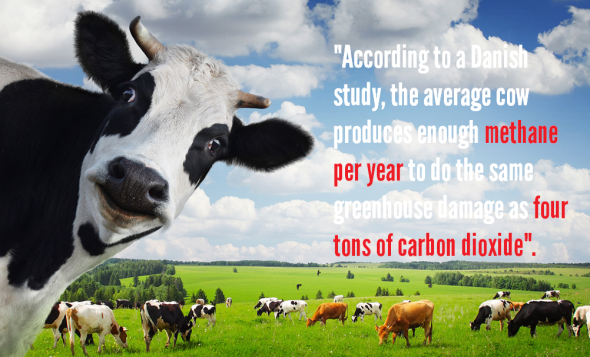
According to a Danish Study conducted back in 2014 for the Intergovernmental Panel on Climate Change cows do emit enough methane per year to do the same damage as FOUR TONS of carbon dioxide. Source: http://www.todayifoundout.com/index.php/2014/04/cow-farts-really-significantly-contribute-global-warming/
At the end of the day I’m just a Botanical, Environmental and Human Scientist with decades of experience within this sector of human, animal and environmental science. I’m not telling you or ordering you what to do, however I am providing to you the facts, of which its down to you whether or not to digest these facts and take action, or to ignore. I do hope that this article is shared far and wide, as well as encouraging many people to make changes to their lifestyle, and to end this so called humane farming of cows - of which is nothing but absolute horrific, nor is it “humane”.
I would just like to correct misinformation here that seems to be going around the animal rights community, I’m not entirely sure why, maybe somethings are done differently in certain countries, however in all farms I have visited, and examined; both “female and male” baby cows are removed from their mother of which as explained above this is called “surplus to the industry”. At times males will be kept if there is a need for further bulls, and at times females will be kept if there is need for fresher milking cows. However if a farmer cannot expand his or her farm or doesn’t require “surplus cows” both females and males will be sold on as veal. Please don’t read and believe everything on the internet, and try to stay focused on “proven and more than academic science”.

Thank you for reading.
To find our more on “non meat consumption visit our coalition partners site here on Facebook
Dr Jose C. Depre PhD. MEnvSc. BSc(Hons) Botany, PhD(NeuroSci) D.V.M.
Environmental & Human Science


